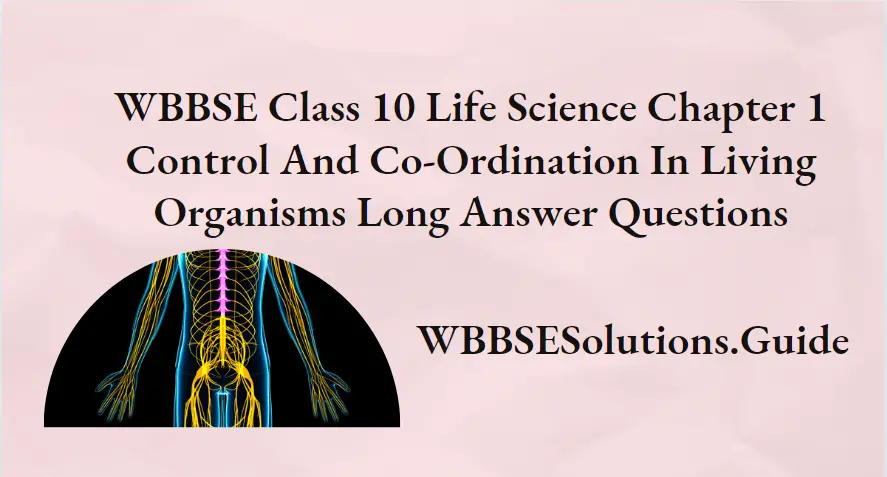Chapter 1 Control And Co-Ordination In Living Organisms Long Answer Questions
Question 1. Describe in brief the locomotion in Amoeba.
Answer.
Locomotion in Amoeba:
Amoeba locomotes with the formation of pseudopodium (singular). During locomotion, a blunt pseudopodium is formed in the direction of movement simultaneously the pseudopodia (pi.) on the opposite side are withdrawn.
Locomotory organ: Pseudopodia.
Type of locomotion: Pseudopodial or amoeboid movement Process: Several theories have been put forward to explain the formation of pseudopodia, of these the sol-gel theory forwarded by Hyman (1917) and later supported by Mast (1925) is the most accepted.
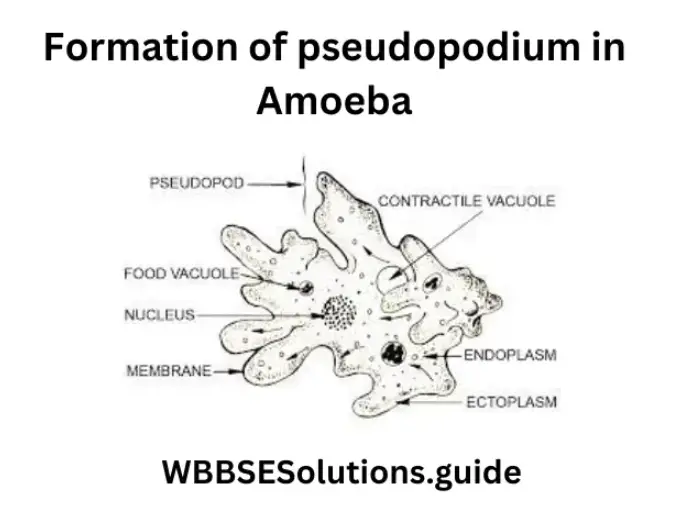
The body of Amoeba is differentiated into three parts. These are (1) a thin and elastic Plasmalemma, (2) an outer non-granular ectoplasm, and (3) an inner granular endoplasm. The endoplasm is further differentiated into an outer jelly-like plasma gel and an inner more fluidy plasmasol. In the formation of pseudopodium, four processes occur simultaneously
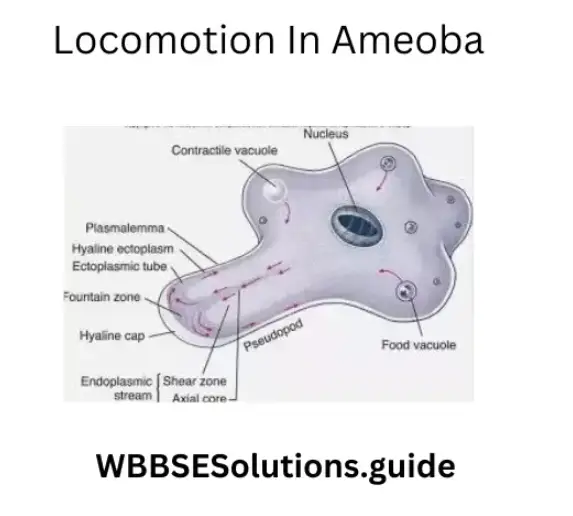
- At the advancing end of the body, the plasma gel partially changes to the solstice (solution) and thus becomes thinner and weaker than the rest of the plasma gel.
- The plasma gel of the opposite end contracts and causes hydraulic pressure on the plasmas.
- Due to the hydraulic pressure, the plasmas are pushed forward towards the softened plasma gel which, being weak, cannot withstand the pressure and develops an outward bulge to receive the plasmas.
- At the periphery of the bulge, the plasmas change into the gel state (gelation). Thus, a tube of plasma gel with a core of plasmas and a covering of ectoplasm is formed. This is the pseudopodium. Pseudopodium is formed in the direction of movement
- Simultaneously the pseudopodia on the opposite side are withdrawn and the amoeba moves forward in the direction of the newly formed pseudopodia.
Question 2. Describe in brief the locomotion in Earthworms.
Answer.
Locomotory organs in earthworms are :
1) Buccal Cavity 2) Setae 3) Body muscles. The buccal cavity acts as a sucker and the setae act as legs. Body muscles are of two types – circular and longitudinal. The alternate contraction and relaxation of these muscles make the body thin and thick respectively.
Type of Locomotion: Creeping locomotion.
Process: Locomotion in earthworms is described in the following six steps :
1. The locomotion starts with the contraction of the circular muscles, which extends to the anterior end. The anterior half of the earthworm becomes thin and elongated.
2. After extending fully the earthworm attaches its mouth (buccal cavity) to the soil which acting as a sucker firmly grasps the soil.
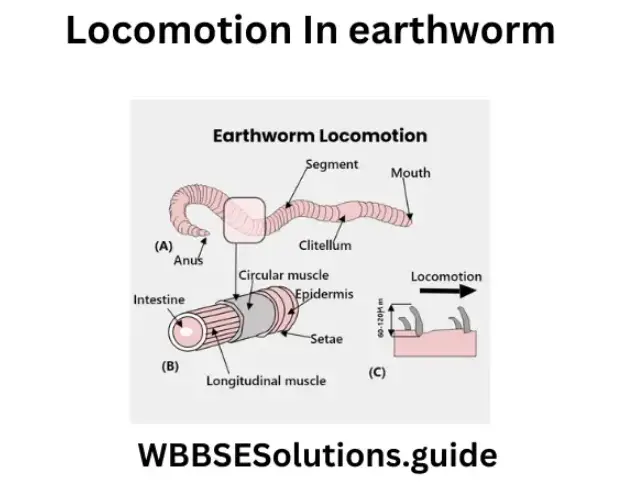
3. Then the setae of the thin region protrude out by the contraction of protractor muscles. The protruded setae firmly grip the soil.
4. At this time the posterior half of the body is free from the soil, and its longitudinal muscles are now ready to contract Due to their contraction the posterior half becomes short
5. After shortening the posterior half, the setae of this region protruded out to take a firm grip on the soil.
6. When the posterior half is completely anchored, the mouth and the setae of the anterior half are withdrawn and the earthworm begins to elongate moving forward. Thus the forward movement is by alternate waves of elongation passing over the whole body. During locomotion, the coelomic fluid serves as a kind of hydraulic skeleton. Sometimes the earthworm may move in a backward direction. It has been calculated that the earthworm can travel a distance of 25 cm in 1 minute.
Question 3. Describe in brief the locomotion of cockroaches.
Answer.
Locomotion of cockroaches
1) Locomotory organs: 1) Three pairs of thoracic legs.
- Pairs of Antagonistic (extensor and flexor) muscles act along the ball and socket joint which divides the leg into five parts.
- Two pairs of wings are present at the posterior side of the second and third segments of the thorax.
- The dorsoventral muscles and longitudinal muscles.
2. Process of Walking Locomotion: It takes place as follows :- The extensor and flexor muscles first contract which causes the straightening of joints in 1st and 3rd leg of one side and the 2nd
- leg of the other side.
- As a result, these legs get lifted and move forward.
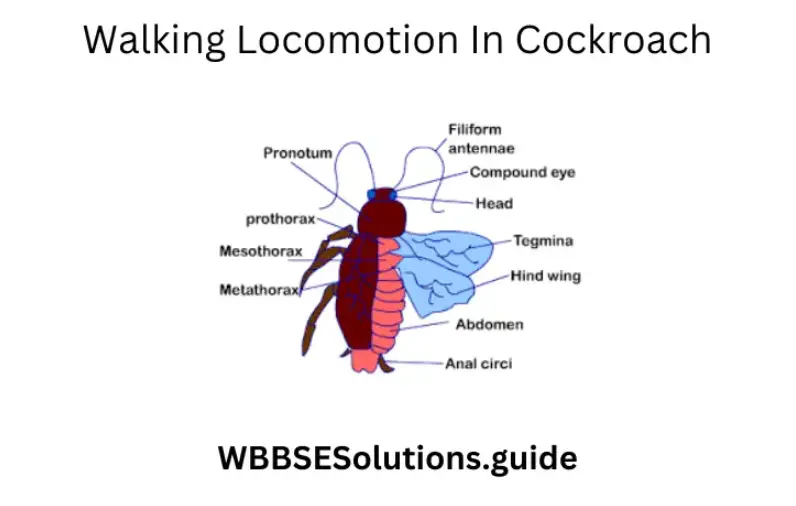
- The other three legs provide support to the body and remain attached to the ground with the help of a claw and sticky pad arolium provided at the terminal portion of limbs.
- Next to it, the extensor and flexor muscles relax which causes the bending of the legs. As such the three legs come back on the ground.
- Similarly, the other three legs are moved forward whilst the remaining ones provide support and in this way cockroach moves forward.
2. Flying Locomotion: The male cockroach only flies during the breeding season and in times of danger. The female cockroach cannot fly.
- Process of locomotion:
The forewings (upper wings) of cockroaches are thick and leathery and are called mesothoracic wings. They are not used for flying. The hind wings (lower wings) are smaller and thin and are called meta-thoracic wings. They are used for flying. The movement of wings is brought about by dorsoventral muscles and longitudinal muscles. The contraction of dorsoventral muscles lowers the dorsal wall of the tergum and thus the wings move upward. The contraction of longitudinal muscles arches the wall upward and so the wings move down. This process is repeated and the movement of the hind wing in the manner of ‘8’ helps to support the body and moves the body forward.
Question 4. Describe in brief the locomotion in fish.
Answer.
Locomotion in fish
Swimming is brought about by the whole of the body.
Fins do not contribute at all to forward movement The main function of fins is to control the stability and direction of the fish.
Locomotory organs: Myotome muscles, tail & tail fins.
Type of Locomotion: Swimming.
Type of fins: Two kinds of fins are present on the trunk and tail: paired fins and unpaired or median fins.
The paired fins are of two types :
1. Pectoral fins: Present close to the head and correspond to front legs of other vertebrates (two in number).
2. Pelvic fins: Correspond to the hind legs (two in number).
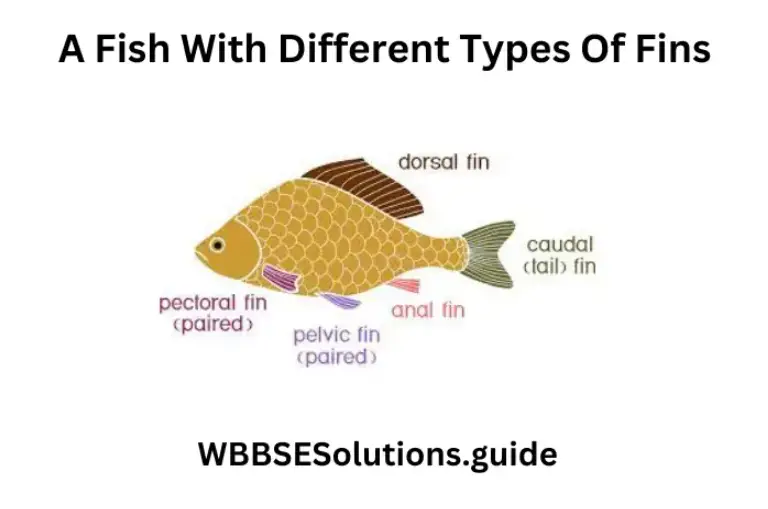
The unpaired or median fins are of three types :
1. Dorsal fin: Present along the top middle line of the trunk (1).
2. Caudal fin : Grows from the tail (1).
3. Anal or Ventral fin: Grows along the middle on the lower side behind the anus (1).
Role of fins in swimming :
1. The paired fins (pelvic and pectoral) control the pitching movement of the fish, causing it to swim downwards or upwards according to the angle at which they are held against water.
2. Pectoral fins help to maintain the fish at rest at any depth.
3. The paired fins are also how the fish slows down and stops locomotion. Thus they act as brakes.
4. The median fins (dorsal, caudal, and ventral) control the rolling and yawing movements of the fish by increasing the vertical surface area presented to the water. During rolling, the median fins prevent the fish from wobbling, i.e., tilting right and left on its axis. Yawing is the tendency to turn in different directions in the same horizontal plane.
Role of myotomes in locomotion (swimming) in Fish :
The fish actively swims by the side-to-side movements of the body particularly the tail. These movements start from the head and continue to the tail like a wave. During the wave of the side-to-side movements, the different regions of the body, from front to back, kick the water backward and sideward, pushing the fish forward. The wave-like movements of the body are a result of the contraction of myotome muscle blocks from the head to the tail in a serial manner and alternation on the right and the left sides.
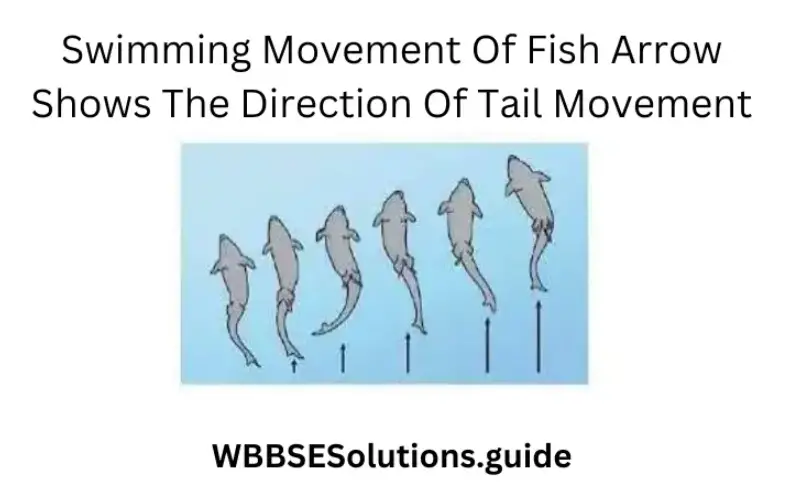
The two successive equal and opposite sideways movements of the tail cancel each other out and the fish moves forward.
Swim bladder: Fishes can stay at a particular depth in the water by making their bodies weightless compared with the surrounding water. Most fish achieve this buoyancy by having in their body cavity an air-filled bladder running just beneath the spinal column. This air-filled bladder is known as the swim bladder (buoyancy organ). It acts like a float in providing buoyancy or upthrust in water.
Question 5. Describe in brief the tactic movement in plants.
Answer.
The tactic movement in plants:
Tactic or Taxis: This type of movement of locomotion occurs due to external stimuli like light, chemicals temperature, etc. The direction of the movement is
controlled by the direction of the stimulus. Tactic movement is of three types:
1) Phototactic movements: Many unicellular algae move towards diffuse light (positive phototactic movements) or away from the light of high intensity (negative phototactic movements), e.g. the movements of the chloroplast in the palisade cells which move and arrange and rearrange themselves in the cell in response to light stimulus and the movements of zoospores of certain algae which move in response to light
2) Thermotactic movements: Here, temperature regulates the change of place or position of a plant Some algae move towards the moderately warmer region of water (positively thermotatic), but away from a region of very high temperature (negatively thermotactic), e.g. the rapid rotational cytoplasmic movement in the leaf of Vallisnaria due to increase in temperature.
3) Chemotactic movements: These movements are induced by specific chemical substances acting as external stimuli. Such movements may be either positively chemotactic (e.g. spermatozoids of fern moving towards the ovum under the influence of malic acid secreted by the archegonium) or negatively chemotactic (e.g. movements of certain bacteria and algae away from acidic or alkaline medium).
Question 6. Briefly describe the different types of tropic movements in plants.
Answer.
Tropic movement in plants: It is a type of movement of curvature that comes under the category of induced or paratonic movement
Definition: When the direction of movement (response) of the plant organs bears a definite relation with either towards or away from the external stimulus, then the movement is called tropic movement
Tropic movements are of the following types, depending upon the nature of the stimuli:
1. Phototropism 2. Geotropism 3. Hydrotropism.
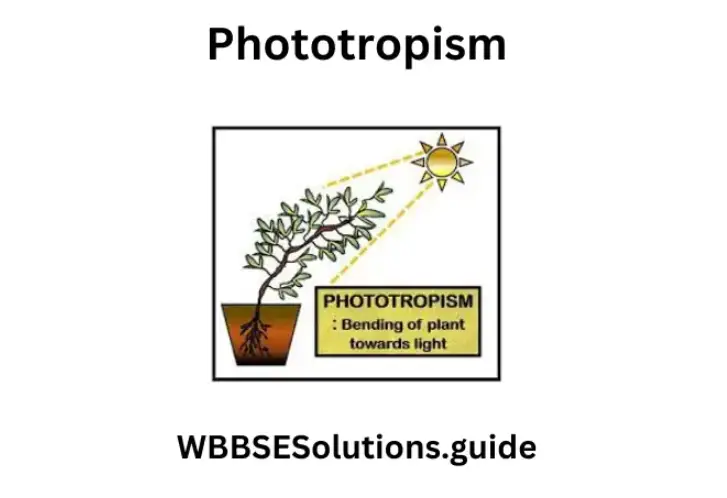

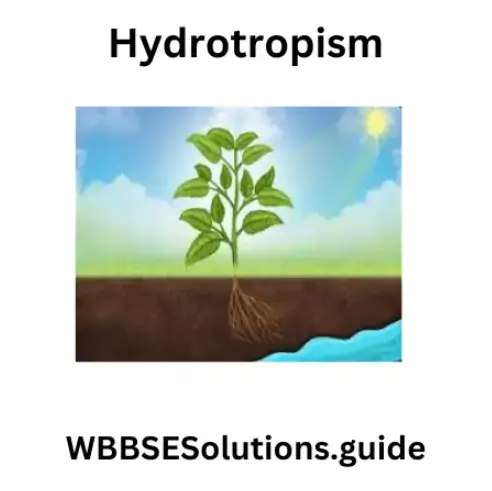
1. Phototropism or Heliotropism: The movement of plant organs in response to the source of light and they are said to be positively phototropic while the roots move away from the source of light and are called negatively phototropic, whereas the leaves and branches grow perpendicular to the sun rays and are said to be diaphototropic.
2. Geotropism: The movement of the plant organs induced by the force of gravity and soil is known as Geotropism or Geotropic movement. Generally, the primary roots move towards the force of gravity in the soil while the primary shoot moves away from the gravitational force of the earth. Thus they are positively and negatively geotropic respectively. The lateral roots and branches grow normally at right angles (perpendicular) to the force of gravity and the movement is called diageotropic. The breathing roots of the Rhizophora plant are an exception, showing negative geotropism.
3. Hydrotropism: The movement of plant organs in response to the source of water is called Hydrotropism or Hydrotropic movement The roots are said to be positive hydrotropic because they move towards the source of water while the shoot system moves away from the water and are said to be negative hydrotropic.
Question 7. Describe nastic movement in plants.
Answer.
Nastic movement in plants: When the curvature movements are induced by the influence of external stimuli light and temperature, they are termed as nastic (paratonic) movement. Nastic movements in which the response, i.e., the movement of plant organs, bears no relation to the direction of the stimulus. The stimulus acts on the protoplasm of cells from all sides.
According to the nature of the stimulus, nastic movements may be photonasty, thermonasty, chemonasty, nyctinasty, seismonasty, etc. where the stimuli are light; temperature, and chemical substances. In nastic movement, the direction of movement is not determined by the external stimuli. The response of the plant organ is always the same from whatever direction the stimulus may come.
1) Photonasty — The movements are concerned with the opening and closing up of flowers, e.g. the flowers of Pentapetes phoenicea fully open at noon, whereas they close at night The opening and closing of leaves of many leguminous plants in day and night afford best examples of photonasty; in these, light from all direction acts as stimulus which causes opening and closing up of leaflets. Similarly, the leaves of Oxalis expand at day time and remain semiclosed and drop at night Light and darkness cause variation in the turgidity of the cell of pulvinar tissues, hence the movement.
2) Thermonasty — The example of the tmonasticcurvature is afforded by the opening of the flowers of Tulips, where an increase in temperature affects the opening of the flower; a consequent fall in temperature brings about the closing of flowers.

This is due to the change in the turgor condition of pulvinar tissue.
3) Chemonasty — It is the movement induced by chemical substances. This type of movement is seen in insectivorous plants. As soon as an insect sits in the center of a leaf of sundew (Drosera sp.), the tentacles move towards it
4) Nyctinasty — It is the most common of the Nastic movements, where changes in temperature and light during the day and night induce visible response which may be termed as nyctinasty. Thus the opening and closing of certain flowers are examples of nyctinasty. Nyctinastic movement of variation due to changes of turgor in the pulvini is also exhibited by the leaf or leaflets of Leguminosae (e.g. clover, Indian Telegraph
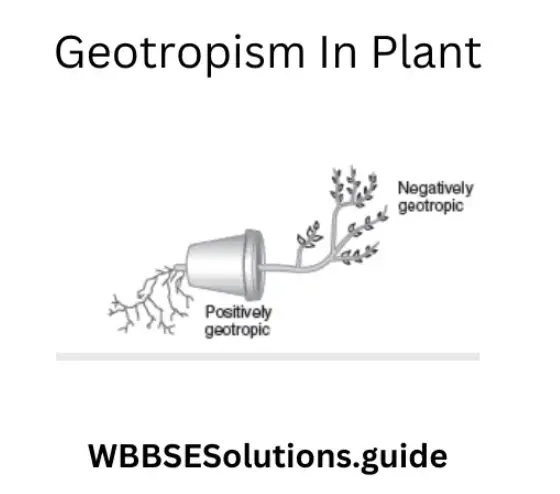
(Oesmodium grants), Acacia, Bauhinita, etc), Oxalidacease (e.g. Oxalis acetosella and also some species of fern and Marsilea). This movement is controlled by both light and temperature. The individual factors acting singly may induce photonastic and monastic movements. These movements are brought about by changes in the turgor of the cells of the pulvinus at the base of the petiole.5) Seismonasty — When a leaf of Mimosa pudica is subjected to sudden touch or shock of any kind, the leaf and its parts droop down very rapidly, and the leaflets close up, altogether, presenting a new appearance.
The movements are brought about by changes in the turgor pressure of the cells of the pulvinus.
Question 8. Give the hormonal explanation of geotropism
Answer.
Hormonal explanation of geotropism
Hormonal explanation of Geotropism: Due to the force of gravity accumulation of hormones takes place more on the undersurface of the root and stem. As root cells need less hormone concentration for their growth, the upper surface grows faster than that of the under surface and as a result root bends downward.
Question 9. Describe the flying locomotion in cockroaches.
Answer.
Flying: Cockroaches rarely fly. Generally, male cockroach flies. There are two pairs of wings held at right angles to the thorax during flight. The fore wings are tough and leathery but the hind wings are thin, membranous, and folded like a fan. The wings are without muscle. The movement of wings is controlled by two different sets of muscles in the thorax. These muscles are not connected to the wings. On muscle runs from the roof (tergum-dorsal surface) to the floor (sternum-ventral surface) of the thorax which is termed dorsoventral muscle or tergo-sternal muscle. The second muscle, the longitudinal, muscle runs anteroposteriorly
Contraction of the dorsoventral muscles (elevator muscle) lowers the dorsal wall of the roof (tergum) and thus forces the wing up. Contraction of the longitudinal muscle
(depressor muscle) arches the dorsal wall or roof (tergum) upwards and so forces the wings down. This process is rapidly repeated for flight In flight the tough leathery forewings
are held at right angles to the body and do not beat. Only the membranous hind wings beat in a complicated manner supporting the body as well as driving it forward.
Question 10. Describe the process of bipedal locomotion in man.
Answer.
The process of bipedal locomotion in man
Process of Bipedal Locomotion in Man: Walking in man is brought about by movements of the legs produced by sets of antagonistic muscles contracting and relaxing alternately. In the first step of movement, the heel bone is raised above the ground due to the contraction of calf muscles. Simultaneously extension of the pelvic joint and knee joint
takes place by contraction of the muscles in front of the thigh. In the next step, muscles contract thrusting the toe backward against the ground, so propelling the body forward, and then lifting the toe from the ground. In the next step, the leg is pushed forward.
When the leg moves forward the body also bends forward and due to the force of gravity and with the relaxation of the muscle the heel first comes down at the ground level and sets down in a new position. The toe then comes down to the ground level.
Question 11. What is a synovial joint? What are its different types?
Answer.
Synovial Joint: A movable joint containing synovial fluid, like a white portion of an egg, is called a synovial joint Synovial joint consists of a ligament, covering of the articular capsule le, synovial membrane surrounding the synovial cavity, synovial fluid inside and articular cartilage.
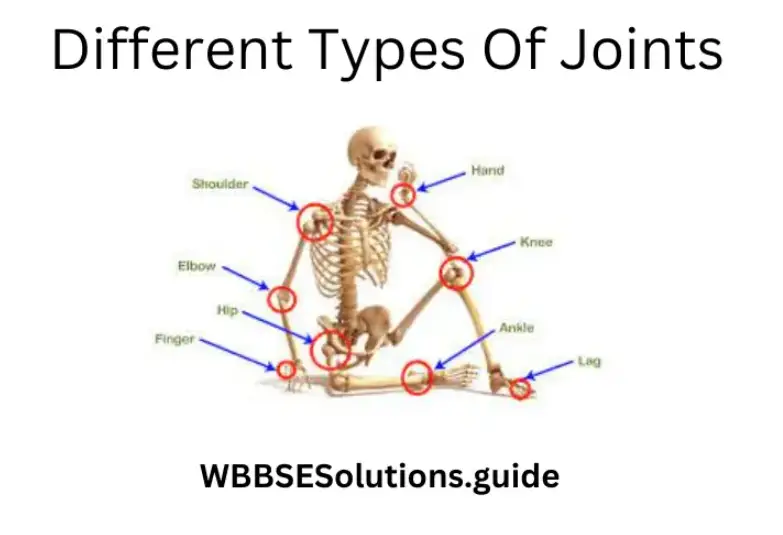
Following are the different synovial joints:
(1) Ball and socket joint: In this type of joint the ball-shaped head (end) of a bone articulate within the cup-shaped head (end) of the other bone; e.g. at the hip the femur or thigh bone joins the pelvis or hip girdle and at the shoulder where the humerus in the upper arm joins the scapula or shoulder blade. Ball and socket joints allow movement in three planes.
(2) Hinge joints: Hinge joints, like those in the elbow, finger, in knee, permit movement in one plane only.
(3) Pivot joint: In this type of joint, the concave end of a bone is attached to the ball-like end of another bone, where the first bone rotates around the head of the second bone. Example: atlas (1st vertebra) and axis (2nd vertebra) joint.
(4) Condyloid Joint: In this type of joint the convex end of a bone joins with the concave end of another bone. Here the movement takes place in one plane only.
For example, joints between the radius and carpal, metacarpals, and phalanges. The different movable joints of the skeleton are enclosed by a capsule of fibrous connective tissue, the synovial
membrane. The ends of each bone are covered with a smooth, slippery layer of cartilage. In the cavity, the bursa, between the articular cartilage, a lubricating fluid, the synovial fluid, is found that is secreted by the membrane lining the joint cavity.
Question 12. Define and classify joints. Name the part of the plant which moves away from the soil. Name the part of the plant that moves towards sunlight. What types of movements are there?
Answer.
Joints
The point at which two separate bones meet is called a joint. There are several different kinds of joints in our body.
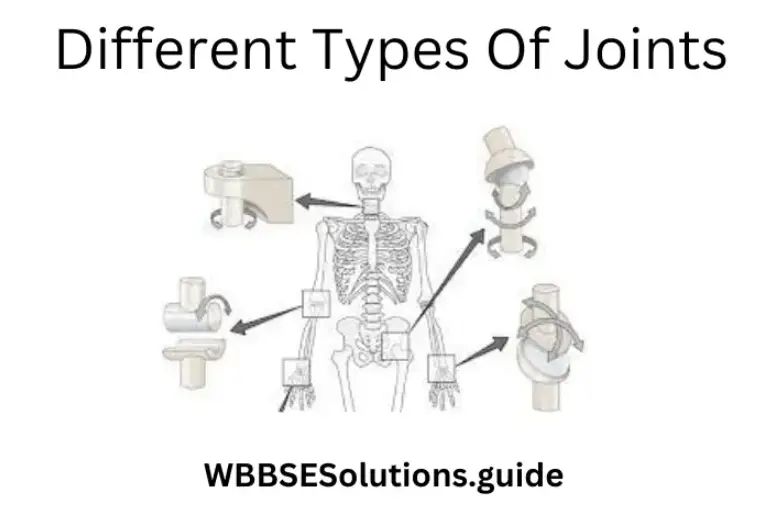
1. Immovable joint: In this type of joint no movement is possible between the two bones. The sutures between the bones of the brain box are examples of immovable joints.
2. Partially movable joint: Here only very little ‘ (partial) movement occurs between the two bones. For example, the joint between a rib and the breastbone or between the vertebrae.
3. Movable joint: In this type of joint varying degrees of movement are possible between the two bones forming the joint.
Question 13. Write two functions of the nervous system. What is a synapse? What is meninges?
Answer.
Functions of the nervous system:
Functions of the Nervous system (a) It controls the different activities of different organ systems of the body, (b) It coordinates functions of organ systems.
Synapse:
Synapse The physiological junction between the dendrites of one neuron and the terminal dendrites of another neuron is called a synapse.
Meninges:
Meninges The membranes that cover the brain are collectively called meninges.
Question 14. What is nerve? Write one characteristic of each of the afferent and efferent nerves. Mention the functions of the cerebrum.
Answer.
Nerve:
(1) Nerve A collection of nerve fibers covered by myelin sheath is called a nerve.
(2) Characteristics of afferent and efferent nerves
(1) Afferent nerve is made up of sensory neurons and it carries impulses from the sense organ to the central organ.
(2) Efferent nerve is made up of motor neurons and it carries impulses from the central organ to the motor organ.
(3) Function of cerebrum
(1) It controls all types of voluntary movements of muscles.
(2) It regulates and co-ordinates the voluntary movements.
(3) It controls the movement of the ball.
Question 15. Write two functions of the cerebral cortex. Describe the protective part of the eyes.
Answer.
Functions of the cerebral cortex
(1) Functions of cerebral cortex (1) Cerebral cortex establishes the conditioned reflex actions through the development of new connections with different subcortical centers.
(2) It controls the activity of autonomic nervous system.
(2) Sclera It is the outermost layer of the eye. It is made of very tough connective tissue and forms the white portion of the eye. This part is called the cornea. It is covered by a membrane called conjunctiva.
Question 16. Wis an isa neuron? Discuss the relation between a neuron and a nerve. What is ganglion?
Answer.
Neuron
(1) Neurone The structural and functional unit of the nervous system is called the neurone.
(2) Relation between the neuron and a nerve Neurone is the structural and functional unit of the nervous system. A bundle of nerve fibers covered with special connective tissue is called a nerve. Relation The nerve fibre of a neurone is the main material of a nerve. Hence, neurons take an active part in the production of a nerve.
(3) Ganglion The structure formed by the fusion of cell bodies of neurons located outside the Central Nervous System is called a ganglion.
Question 17. What do you understand nervous system? Mention the characteristics and features of afferent and efferent nerves. What is a synapse?
Answer.
Nervous system:
(1) Nervous system The organ system which is only present in higher group of animals whose main function is to control and coordinate the functions
of other organ systems of the body, called the nervous system.
(2) Characteristic features of afferent nerve
(1) It is made by nefibersbres of sensory neurons.
(2) It carries impulses from the receptor of sense organs to central organs (brain and spinal cord).
(3) Characteristic features of efferent nerve
(1) It is made by nerve fibers of motor neurons.
(2) It carries impulses from the central organ to the motor organ (Muscles and glands).
(4) Synapse The physiological junction between the terminal, dendrite neuronurone with the dendrite of another neuron is called a synapse.
Question 18. Describe in brief the three main parts of the human brain. Mention two functions of skin as a sense organ.
Answer.
Three main parts of the human brain
(1) Structure of three main parts of the human brain
(1) Cerebrum, (2) Cerebellum, (3) Medulla oblongata.
(1) Cereb It is the largest part of the brain. It is ® the part of the full brain. Its mass is 1050 gm. It has a fissure in its length due to which it seems it is made by two hemispheres. The shape of each part is semi-spherical. This part has sulci and gyrus.
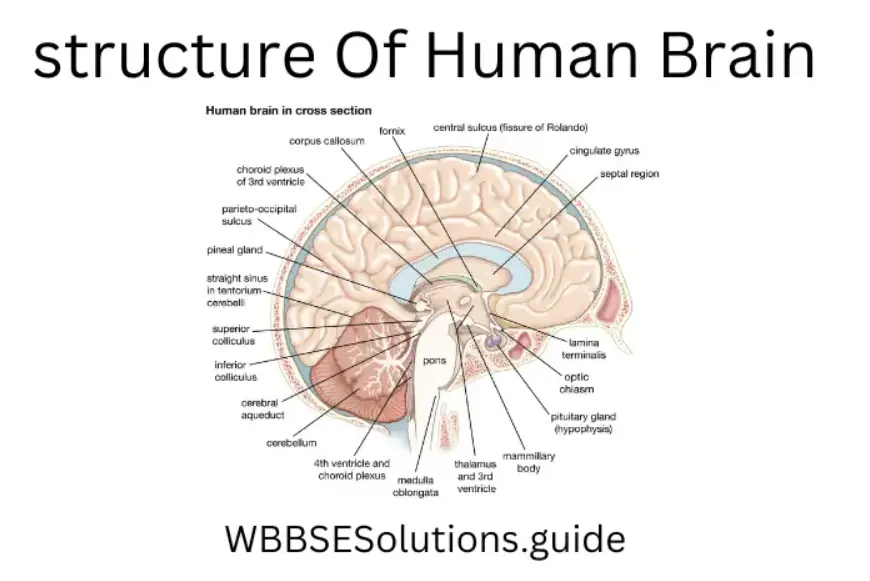
(2) Cerebellum It is fully covered by cerebrum. It is divided into two parts (left and right). The left part is related to left-organ scans and the right part is related to the right-side organs of the body.
(3) Medulla oblongata is the lowest part of the brain. It is located between the cerebellum and the Spinal Cord. Its outer and inner parts are made up of white matter and grey matter respectively.
(2) Two functions of skin as a sense organ
(1) It receives external stimuli! (i.e., hot, cold, pain of Alpin)
(2) It realizes pressure and weight
Question 19. What is a nerve? What is its function? Mention the characteristics of two main types of nerves and cite examples.
Answer.
Nerve:
(1) Nerve A collection of nerve fibers covered by myelin sheath is called a nerve.
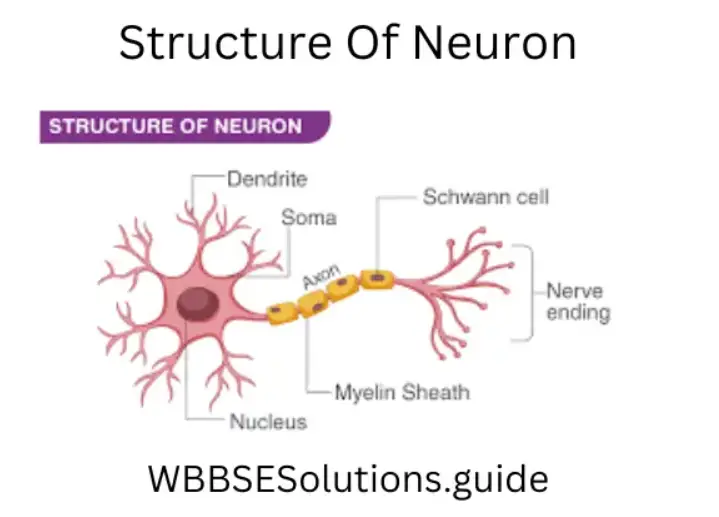
(2) Function of a nerve It carries impulses from receptor organs to the central organ and from the central organ to motor organs.
(3) Characteristics of afferent and efferent nerves (1) Afferent nerve is made up of sensory neurons and it carries impulses from the receptor of the sense organ to the central organ.
(2) Efferent nerve is made up of motor neurons and it carries impulses from the central organ to the motor organ.
(4) Examples (1) Olfactory nerve, (2) Optic nerve.
Question 20. Write one main difference between sensory and motor nerves with one example each. Mention one function of each of gibberellin, cytokinine, and thyroxine.
Answer.
Main difference between sensory and motor nerves
(1) Function of Gibberellins It promotes the development of fruits without seed.
(2) Function of Cytokinine It takes part in the cytokinesis of plant cells.
(3) Function of Thyroxine By increasing the blood sugar level, synthesizing protein (in low dose), and depressing protein synthesis (in high dose) it influences metabolism.
Question 21. Describe the structure of the human eye. Explain the mechanism of vision.
Answer.
The structure of the human eye
Each eye is spherical. It lies in a cavity in the skull called the eye socket and is attached to it by three pairs of muscles that move it in different directions. The eyeball is hollow.
Structure Eye is made up of three layers
(1) Sclera, (2) Choroid, (3) Retina.
(1) Sclera It is the outermost layer. It is made of very tough connective tissue and forms the white portion of the eye. This part is called the cornea. It is covered by a membrane called conjunctiva.
(2) Choroid It is the middle layer. It contains many capillaries. It supplies nutrients to the inner parts of the eye. The choroid forms the pigmented muscular curtain which is called the iris. The hole of the iris is called the pupil which is round-shaped
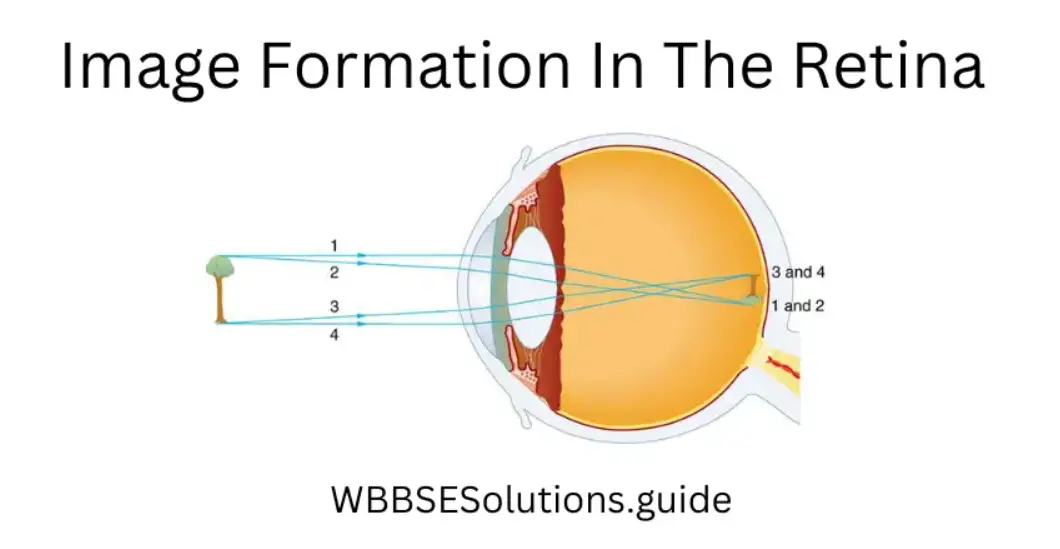
(3) Retina The innermost layer which is a very delicate sheet of tissue, called the retina. This layer contains the rod and cone cells which are sensitive to light and color respectively. These cells are more closely packed at a spot point. This spot is called the yellow spot Optic nerve meets at a point of this layer. This point is called the blind spot. Here sensory cells are absent. The place of the retina at the front of the eye is taken by the circular transparent biconvex lens which is held in place by suspensory ligament The suspensory ligament is attached to the choroid coat at its outer edge. The part of the eye in front of the lens is filled with watery aqueous humor. The part behind the lens is filled with telly-like vitreous humor.
Mechanism of vision All the transparent parts of the eye allow light to pass through them. The pigmented parts limit the amount of light entering the eye. The iris allows light to enter the eye only through the pupil. The cornea, aqueous humor, lens, and vitreous humor all act as refracting media. They make the images falling on the retina clear and detailed. The images formed on the retina are inverted (real), but in the brain, this is corrected to give the impression of an erect object
Question 22. How many types of reflex actions are there? Explain with examples.
Answer.
(1) Types of reflex action There are two types of reflex action :
(1) Inborn or unconditioned reflex action.
(2) Conditioned reflex action.
(1) Inborn or unconditioned reflex action A reflex action that is present in the body from the time of birth is called unconditional or unconditioned reflex action.
Example – Knee Jerk reflex action.
(2) Acquired or conditioned reflex action The reflex action that is acquired as a result of repeated training after birth is called acquired or conditioned reflex action.
Example – Salivation in the absence of food but in the presence of a stimulus like a ringing bell.
Question23. What is Auxin hormone? Write three functions of this hormone.
Answer.
Auxin hormone:
(1) Auxin: A group of nitrogenous orgaadsadds containing an indole group produced within meristematic tissue of root and stem apex is called Auxin.
(2) Functions of auxin –
(1) Controlling weeds: By spraying 2,4-D (2,4 – Dichloro phenoxy acetic acid) unwanted dicotyledonous weed plants can be destroyed from the field mono-cotyledonousous crops like wheat.
(2) Rooting of cutting: Cutting is a method of artificial vegetative reproduction. One end of the branch is dipped into a solution of Auxin before placing it into the ground. It increases the rate of rooting.
(3) In parthenocarpy: It helps in the formation of seedless fruits.
Question 24. What is the unit of the nervous system? Mention the names of its three major parts. What is reflex action? Cite one example of reflex action.
Answer.
(1) Name of the unit of nervous system Neurone.
(2) Name of three major parts of neuron (1) Cell body, (2) Dendron, (3) Axon.
(3) Reflex action The involuntary automatic actions controlled by the Central Nervous System are called reflex action.
Example Uplift of leg when touched with a hot object
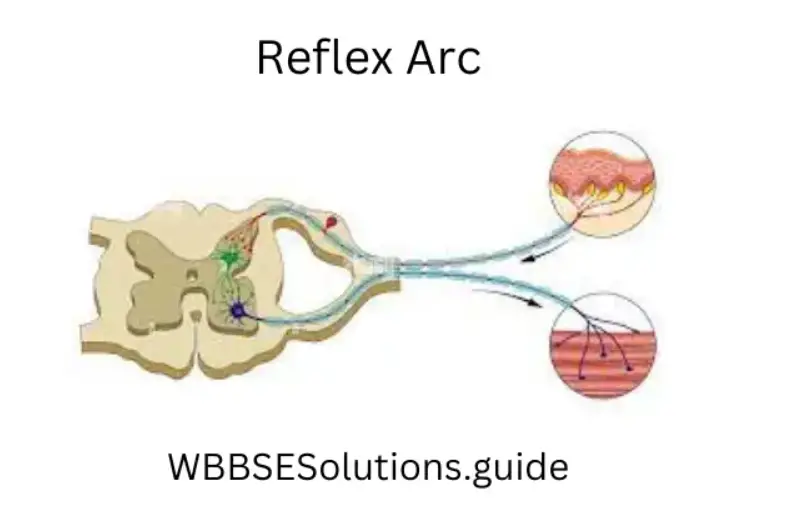
Question 25. Mention the sources of gibberellins and kinins. Discuss the applicative aspects of plant hormones in agriculture.
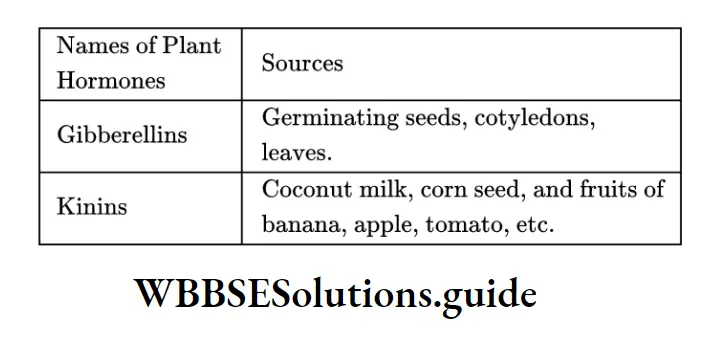
(2) Applicative aspects of plant hormones in agriculture
(1) In the destruction of weeds Dicotyledonous herbs like amaranthus are removed from the field of monocotyledonous crops like wheat by the spray of 2.4 -D and 2,4,5 Tricholorophenoxy acetic acid.
(2) Prevent sprouting The development of adventitious buds of tubers is controlled by the use of auxin. So, potatoes can be stored for a longer time.
(3) For early rooting During cutting IAA and IBA are used at the cut ends. It initiates early rooting at the cut ends.
Question 26. Write two functions of gibberellines. How is glucose regulated in the blood? Which hormone decreases glucose levels in the blood?
Answer.
Functions of Gibberellins –
(1) It checks and minimizes the dormancy period of seeds.
(2) It takes part in sex determination.
(2) Process of regulation of glucose in the blood:-
Regulation of glucose in the blood is done by insulin. It increases the rate of glucose absorption and stimulates the process of glycolysis. It also helps in the synthesis of glycogen in liver and muscle cells. It prevents the conversion of glycogen to glucose. It induces the synthesis of fat from glucose in adipose tissue and maintains the glucose level in the blood.
(3) Insulin.
Question 27. Why are hormones called chemical coordinators in the living body? Write the site of formation and any two functions of the Gibberelline hormone.
Answer.
(1) Hormones a£ chemical co-ordinator in the body of an organism:- Hormones are complex organic chemicals that are produced in one part of an organism and obtain information about their function from here and then transported to another part of the organism where they perform their function. Hormones control the various metabolic reactions and bring a co-ordination between different metabolic reactions.
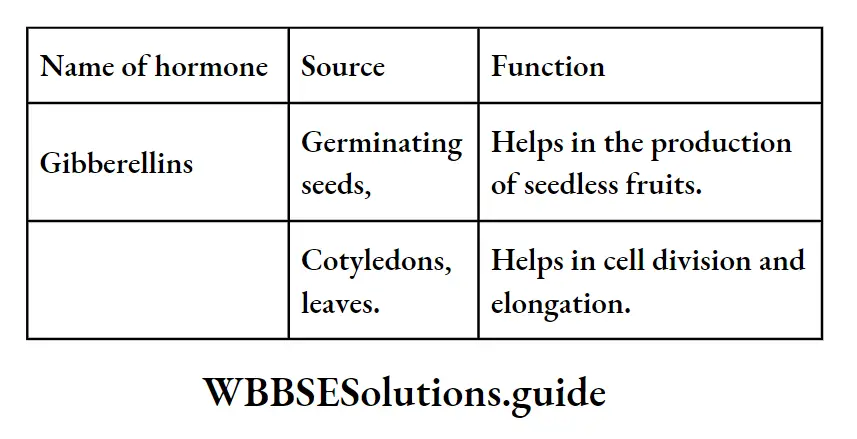
Question 28. Which hormone is known as the ’emergency hormone’ and why? Write the sources of gibberellin and any two functions of the hormone.
Answer.
(1) Adrenalin hormone is known as emergency hormone. Reason:- It is secreted at the time of danger and helps to control sudden excitement by influencing the nervous system and increasing blood flow, thereby helping the person to face the abnormal condition successfully.

Question 29. Where is the thyroid gland located? Name the hormones secreted from it. What are the main functions of those hormones?
Answer.
(1) The thyroid gland is situated at the root of the throat, one on either side of the trachea. The two lobes are joined by an isthmus, which is situated in front of the 2nd, 3rd, and 4th tracheal rings.
(2) (1) Thyroxine (2) Calcitonin.
(3) Functions of Thyroxine
(1) Thyroxine increases the metabolic activities of almost all the tissues of the body.
(2) It has effects on growth.
(3) It causes vasodilation in most body tissue, thus increasing blood flow.
(4) It increases the rate of heartbeat
(5) It increases the rate of respiration.
(6) It increases the rapidity of secretion of the digestive juice.
Function of Calcitonin
(1) It promotes the deposition of calcium in the bones and decreases extracellular fluid calcium ion concentration.
(2) It maintains calcium balance in the blood.
Question 30. What is the source of estrogen and testosterone hormones in the human body and write two functions of each.
Answer.
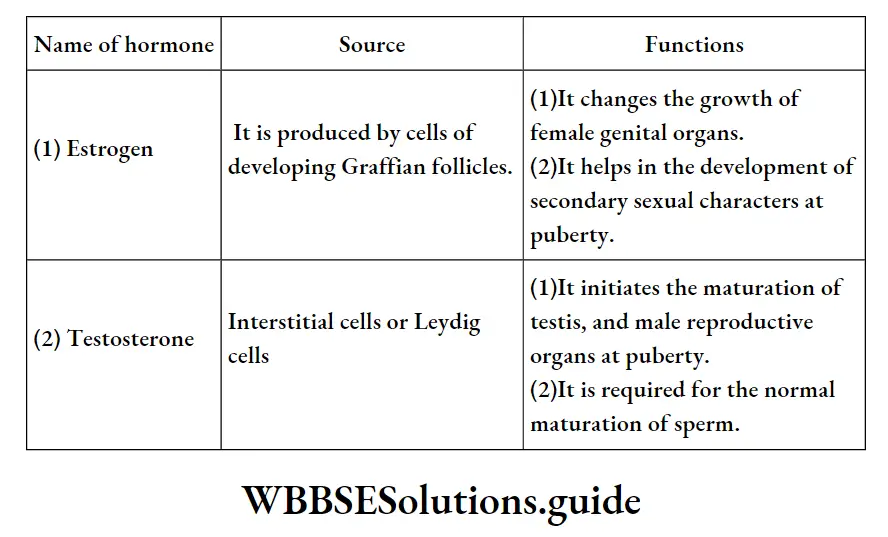
Question 31. Mention the names of two female sex hormones and one function of each of those.
Answer.
(1) Estrogen (2) Progesterone.
The function of Estrogen Estrogen controls the development of female sex organs and female features.
The function of Progesterone Progesterone controls the uterus changes in the menstrual cycle.
Question 32. Wherefrom are TSH and thyroxine hormones secreted? Mention any two functions of the thyroxine hormone. Name the diseases caused by to hyposecretion of this hormone among children and adults.
Answer.
(1) TSH (Thyroid Stimulating Hormone) is secreted from the anterior lobe of the pituitary gland.
Thyroxine is secreted from the thyroid gland.
(2) Function of thyroxine hormone (1) It controls metabolic reaction.
(2) This hormone helps in the development of the nervous system.
(3) Children – Cretinism, Adult – Myxoedema.
Question 33. Mention the source of Insulin. Mention the functions of this hormone. Which hormone is called emergency hormone and why?
Answer.
(1) Beta cells of islets of Langerhans (pancreas) are the source of Insulin.
(2) It reduces the blood sugar level by converting glucose into glycogen.
(3) Adrenalin is called emergency hormone. Because it gives courage to the
individual during an emergency period, i.e., anger, fear, etc.
Question34. Which hormone is known as the “Emergency hormone”? From which gland is it secreted? Discuss two functions of that hormone. Mention the place of secretion and the place of action of auxins.
Answer.
(1) Name of Emergency Hormone Adrenaline.
(2) Name of the gland Adrenal medulla.
(3) Function of Adrenaline (1) It increases the rate of blood circulation, (2) It increases the rate and depth of respiration.
(4) Place of secretion of auxins Apical meristematic tissue of root and stem.
(5) Place of action of auxins It acts at the place of cell division and cell elongation.
(3) Sites of secretion and functions of insulin and adrenaline hormones :
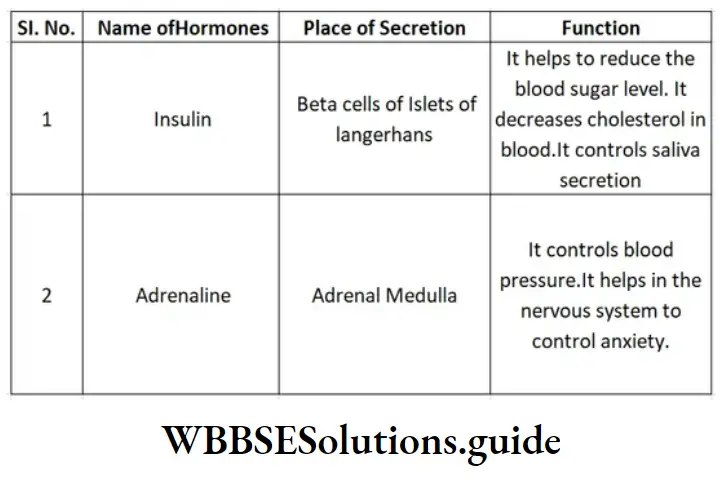
Question 35. Name three animal hormones that are not secreted from the pituitary gland mention their sources and write the functions of any two of those hormones.
Answer.
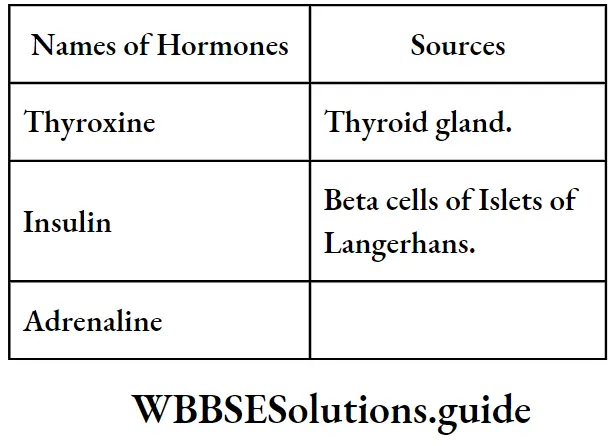
(2) Functions of thyroxine and insulin
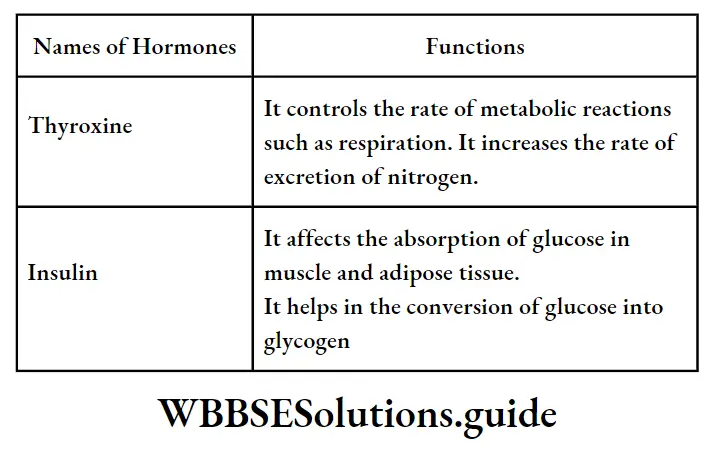
Question 36. Which gland is considered the master gland and why? Mention the name band function of two trophic hormones secreted from this gland.
Ans. (1) (1) Pituitary gland is considered as the Master gland.
(2) Reason This gland is considered a Master gland because some hormones secreted from its anterior lobe control the functions of another endocrine gland.
(2) (1) TSH (Thyroid Stimulating Hormone) It initiates the thyroid gland to secret thyroxin.
(2) GTH (Gonado Trophic Hormone) influences the growth of the testis in males and ovaries in females.
Question37. Write two characteristics of hormones. Why is a hormone called the “chemical messenger”? Mention one functional difference between the nervous system and the endocrine system.
Answer:
Characteristics of hormones
- Their molecular weight is low.
- Their remaining quantity is destroyed and excreted at the end of the reaction.
- Because they have received orders from their place of production (such as endocrine glands) and act accordingly on the target organs.
- Nervous System
- It does not take part in metabolism.
- Endocrine System
- It takes part in metabolism.
Question 38. Name two hormones that are responsible for apical dominance and division of cytoplasm in plant cells respectively. Write the full name of two hormones produced in the anterior pituitary and one function of each.
Answer.
(1) Hormone responsible for apical dominance —Auxin
(2)Hormone responsible for the division of —– cytoplasm
(3) (1)TSHACTH —ThyroidAdrenoStimulatingCortico (2)TrophicHormoneHormone—Cytokinin.
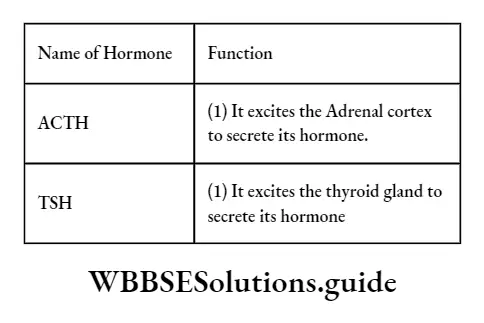
Question 39. Describe the parts of the Nervous system.
Answer.
Parts of the Nervous system
(1) Central Nervous System (CNS): This part of the nervous system is the supreme controller of all body responses. CNS includes :
(1) Brain or Encephalon, which occupies the cranial cavity, and contains the higher governing centers.
(2) Peripheral Nervous System (PNS): All nerves originating from the CNS and constituting the PNS are subdivided into the following two components :
(1) Cerebrospinal nervous system: It is the somatic component of the PNS which includes 12 pairs of cranial nerves (originating from the brain) and 31 pairs of spinal nerves (originating from the spinal cord). It innervates (supplies) the somatic structures of the head and neck, limbs, and body wall.
(2) Autonomic nervous system (ANS): It is the visceral component of the PNS which includes the visceral or splanchnic nerves. It innervates the viscera, glands,
blood vessels and nonstriated muscles.
ANS consists of two divisions :
(1) Sympathetic and (2) para-sympathetic systems.
These two systems have antagonistic effects, i.e., while one system promotes the activity of the organs, the other system retards. Thus they control and co-ordinate the activities of internal or visceral organs. This coordination is involuntary
Question 40. What is the unit of the nervous system? Describe its structure and functions.
Answer.
Unit of the nervous system
(1) Neuron(e) is the unit of the nervous system.
(2) Structure of Neuron (e): It is the structural and functional unit of the nervous system and consists of a nerve cell body with all its processes.
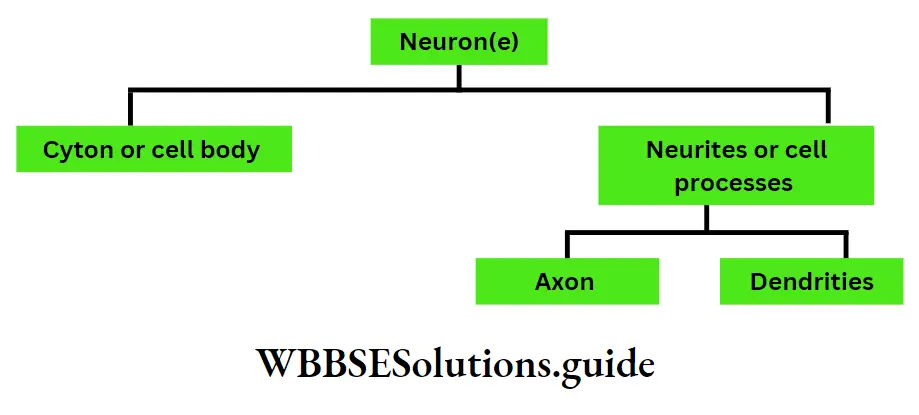
1. CYTON : (also called soma or perikaryon)
The soma is present In the following places of the nervous system.
(1) In the grey matter of CNS.
(2) small clusters called ganglia in the PNS.
It is found in different sizes and shapes (spherical, oval, spindle, etc.) It consists of the following :
1. Neuroplasm: It is a mass of cytoplasm surrounded by a cell membrane.
Various structures are suspended in it
2. Nucleus: It occupies the central part of the soma and contains, usually, one prominent nucleolus.
Function: Controls all the functions of the cyton.
3. Nissl bodies (also called tigroid substances): They are named after the discoveror Franz Nissl. These are granular structures (maybe rod-shaped) present all over the cyton. They may extend in the dendrites but not in the Axon.
Function: They synthesize the proteins of neurons.
4. Mitochondria: It is present both in cyton and axon.
Function: Performs respiration (production of ATP)
5. Neuro-fibrils: These are thread-like structures. They are present in both soma and neurites.
Function: They transmit impulses.
6. Centrioles: In the past, it has often been stated that centrioles are not present in neurons but studies with the electron microscope have shown that centrioles are present.
Function: They help in the production and maintenance of micro-tubules. Besides these, some other structures are also present
1. Golgi apparatus
4. Lyso-somes
2. Neurites or cell processes :
The processes arising from the cell body of a neuron are called neurites. These are of two kinds : (1) Dendrites and (2) Axon.
1. Dendrites or Dendrons: These are short; numerous, afferent processes arising from the different regions of the cyton. They are characterized by the following :
(1) They are tapering processes, i.e., thick at the origin but much thinner at the end.
(2) They branch repeatedly and irregularly.
(3) They bear numerous small spines called Gemmules to increase the surface area.
(4) Their cytoplasm consists of neurofibrils,missess granules, and mitochondria.
(5) They are rough in external appearance.
Functions :
1. They receive the sensory impulses and conduct them towards the cell body.
2. In some cases they modify to act as receptors, e.g. Dendrons of olfactory cells modify into olfactory rods and receive impulses or olfaction (smell) in the olfactory region of our nose.
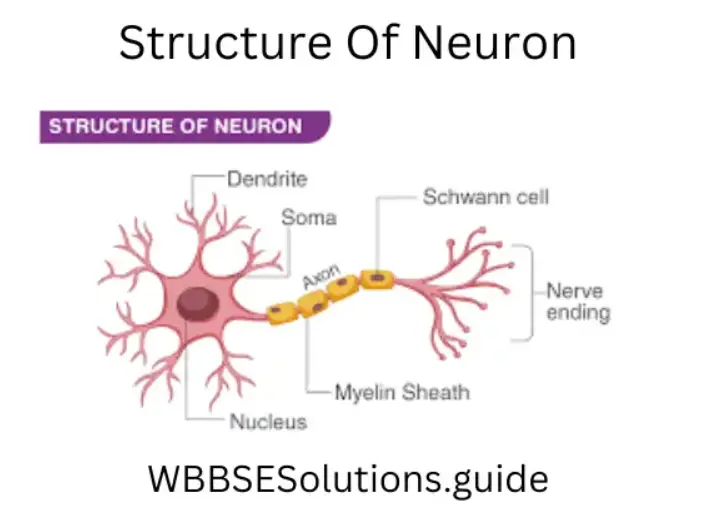
2. Axon or Axis Cylinder or Neuraxon: It is a single long efferent process arising from the axon hillock of the cyton and is of uniform thickness. It is better known as “nerve fiber”. Based on the presence of myelin sheath, it is of two types:
(1) Myelinated and (2) Non-Myelinated nerve fibers.
(1) Myelinated or Medullated Nerve Fibers: As the name suggests, they are surrounded by a layer of the myelin sheath. The nerves look white (due to the high refractive index of the myelin sheath). The great majority of nerve fibers in our body are myelinated nerves. They are found in
(1) The white matter of central nervous system.
(2) The peripheral nerves. It consists of the following parts from inside outwards
(1) Axis Cylinder: It constitutes:-
The Axoplasm: It is the central core of the axon and is pasty (semi-fluid) in nature. Within the axoplasm (1) mitochondria, (b) axoplasmic vesicles and
(2) neuro fibrils can be seen but its granules are absent (It also contains axis fibrils that run parallel to the axis of the fiber).
Axolemma: The axoplasm is ensheathed (covered) by a membrane called axolemma. It is a non-nucleated, semi-permeable membrane.
Functions: Many substances like proteins are not synthesized by the axon but are formed by the cyton. These substances are transported from the cyton to the whole of the axon by the axoplasm. This transportation is called axonal flow.
(2) Myelin sheath or Medullary sheath: Outside the axis cylinder lies the myelin sheath. Myelin has a whitish appearance. The sheath is made up of lipid materials and protein. It is formed by:-
(1) The Schwann cells (In peripheral nerves)
(2) Oligodendrocytes (In the nerves of CNS)
Functions : (1) Increases the speed of conduction of nerve impulse, (2) Acts as an insulator by reducing loss of electrical activity.
(3) Neurilemma (Neurolemma) (Also called Schwann cell sheath): This is the externalmost covering of the axon. It is unbroken and nucleated.
Functions: It helps in the regeneration of nerves.
(4) Nodes and Inter-nodes: The myelin sheath does not form a continuous sheath but is interrupted at regular intervals. The gaps so produced are seen as constrictions or nodes known as the Nodes of Ranvier. The segment of the axon between two successive nodes is called an “Inter-nodal segment”. The longer the segment, the faster the rate of conduction of nerve impulses.
(5) Schwann Cells: They lie between the neurilemma and the myelin sheath. In between two nodes of Ranvier, there is a single cell consisting of one (and only one) nucleus of Schwann.
Function: They are responsible for the formation of the myelin sheath.
(6) Endoneurium: It is a tube of connective tissue that envelopes each nerve
Fibre outside the neurilemma.
Wbbse Class 10 Life Science Question Answer
(7) Branches of axon: An axon may give off a variable number of branches. At its termination, the axon breaks up into several fine branches called telodendria. From the sides of the axon, several branches arise at right angles and are known as collaterals. The collaterals and telocentric often form small bulbous swellings at the synapse called terminal boutons (or bouton teminaux).
2) Amyelinated or Non-medullated nerve fibers (Also called fibers of the remark): These nerve fibers are called non-medullated because they have no myelin sheath. Thus, their diameter is very small. It consists of an axis cylinder covered by neurilemma with a single cell of Schwann. Nodes of Ranvier are absent They are found in :
(1) The grey matter of CNS. (2) The peripheral nerves. The function of Axon: They transmit the impulses away from the cell body to the other neurons via a synapse.
Question 41. How many types of neurons are there?
Answer.
Neurons are classified on the following basis:-
(1) based on the direction of transmission of impulses :
(1) Motor neurons: Transmit impulses from the CNS to the effectors.
(2) Sensory neurons: Transmit impulses from receptors to the CNS.
(3) Intermediate neurons: Confined to the CNS and connect the motor and the sensory neurons.
(2) based on the number of fibers arising from nerve cells :
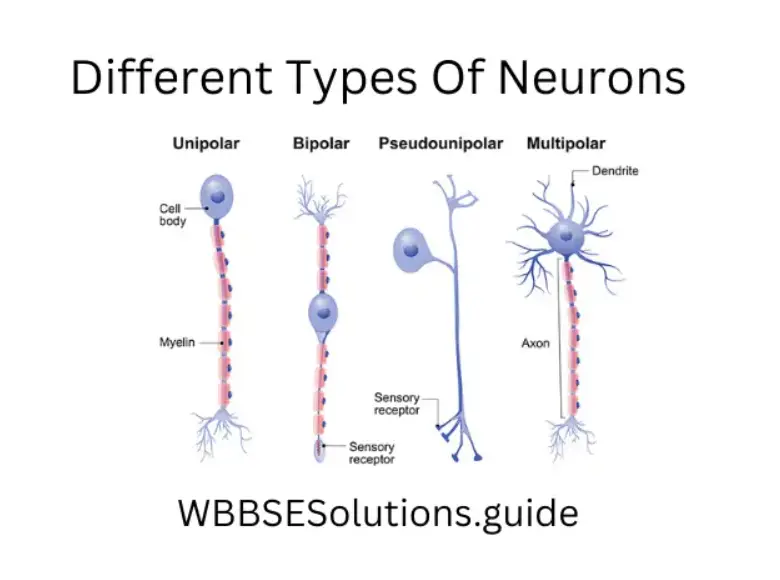
(1) Apolar: Having no axon or dendrites.
(2) Unipolar : A neuron with a single fibre.
(3) Bipolar: A neuron with two fibers, e.g. a neuron with one dendrite and one axon.
(4) Multipolar: A neuron with many fibers.
(3) based on the presence of myelin sheath :
(1) Myelinated: Those neurons whose axons have a covering- of the myelin sheath.
(2) Non-Myelinated: Those neurons whose axons do not have a covering of myelin sheath.
Question 42. Name the different cranial nerves. Mention the organs innervated and their functions.
Answer:
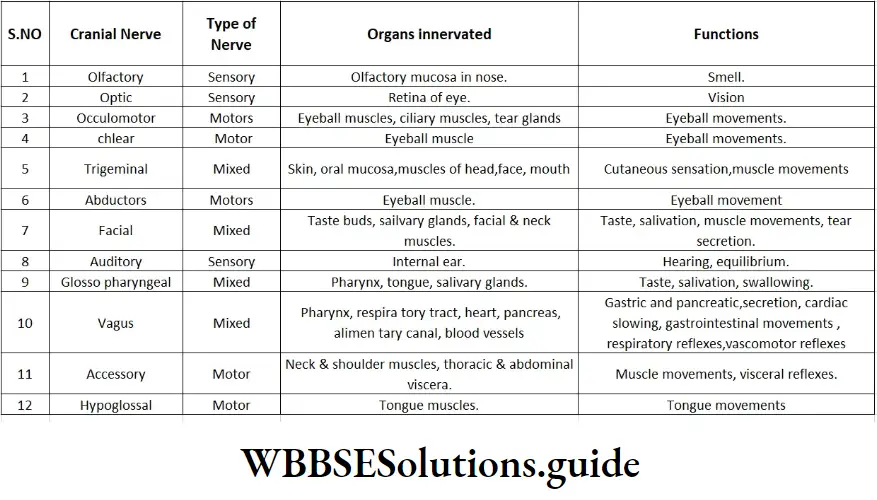
Question 43. What are the characteristic features of afferent and efferent nerves?
Answer.
Characteristic features of afferent nerve :
1. It is also called sensory nerve.
2. It arises from the dorsal horn and runs through the dorsal nerve root of the spinal cord.
3. It connects the sensory organs to the brain and spinal cord.
4. It carries the stimulusthe the brain and spinal cord the the rom sensorgansrgan.
5. They are generally unipolar or bipolar.
Example : 1st, 2nd & 8th cranial nerves.
Characteristic features of efferent nerve :
1. It is also called a motor nerve.
2. It arises from the right ventral horn and runs through the ugh ventral nerve root the the of spinal cord.
3. It connected the cts brain and spinal cord to the effector organs, that is, muscles and glands.
4. It carries impulses from the brain and spinal cord to the effector organs.
5. They are generally multipolar. Ex: 11th & 12th cranial nerves.
Wbbse Class 10 Life Science Question Answer
Question 44. What is the importance of the nervous system? Write the name of the structural and functional unit of the nervous system.
Answer.
Importance of the nervous system
(1) The importance of the nervous system is explained as follows :
(1) It controls, harmonizes, and regulates all voluntary muscular activities, involuntary activities such as breathing, heating of the heart, rates of secretion of some endocrine gland and ds, rapidly changing visceral ever to bring about coordination among the various organs of the body.
(2) It is responsible for memory and intelligence and provides higher mental processes, i.e., consciousness, ambition, and judgment It is also responsible for emotional activities. Thus it enables us to remember, to think, and to reason.
(3) The nervous system acts as a museum of past incidents and experiences.
(4) The stimuli in the form of nerve impulses travel along the incoming nerve from the receptors to the spinal cord and the brain. Here the impulses are analysed and order is passed into other outgoing nerves which lead the information from the brain to the effector organs which then makes a suitable response.
(2) The structural and functional unit of the nervous system is the neuron.
Question45. Mention the functions of any three of the arts of neurons.
Answer.
The function of the ions of three main neurons neurons are
(1) Cyton or cell body: Its functions are
1. It receives nerve impulses from its dendrite and transmits them to the axon.
2. It produces nerve processes.
3. It also provides space for the attachment of nerve processes.
4. The Nissl bodies contain RNA and act like ribosomes.
5. It has some degeneration generation and regeneration of neurons.
(2) Dendrites (Dendron) Its functions are
1. They impulses impulses from the axon of the other, neuron and send the impulses
to the cell body.
2. It establishes fun relations relation with other neurons.
3. In some neurons dendrites are modified into receptors.
3) Axon: Its functions are:-
1. Axons act as efferent processes that receive impulses from the cell body and transmit
them to the next neuron through synapses or to the muscles through
junctions.
2. It establishes junctional relations with other neurons.
3. It takes part in the formation of nerve fibers.
Question 46. What is a synapse? Mention one similarity and one dissimilarity between the functions of the nervous system and hormones in the animal body.
Ans.
Synapse – The specialized junctions of neurons with one another or with effector organs (muscle or gland) are termed synapses.
OR, The point of junctional communication or contact between the dendrites of one neuron and the axon or cell body of another neuron is called a synapse.
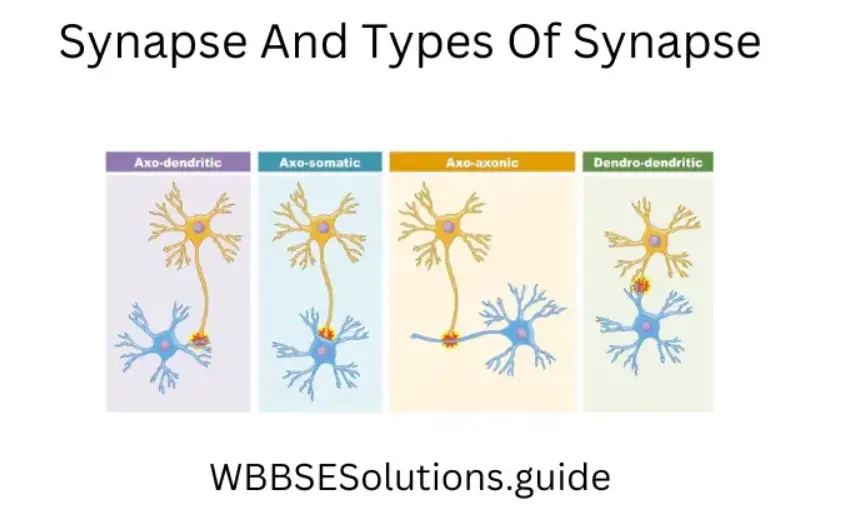
(2) Distribution – Synapses occur in the central nervous system and the ganglia of the autonomic nervous system.
(3) Types – 1 . Axoaxonic
2. Axosomatic 3. Axon dendritic.
(4) Function – Transmission of impulse between the neurons.
2. Basis Nervous system And Hormone
similarity coordination
Dissimilarity physicochemical chemical coordinator
Rapid in action slow in action
47. What is neurone ? Discuss the relation between a neuron and a nerve. What is ganglion?
Answer.
Neurone
(1) Neurone or nerve cell is the structural and functional unit of the nervous system. It consists of main three parts, viz. 1. Cell body or cyton., 2. Axon.,
3. Dendron. Its main function is the transmission of impulses.
(2) Neurone-nerve relation: A nerve is a bundle of nerve fibers ensheathed by connective tissue. Neurone is made up of an axon, having cyton or cell body and dendrites. Axon is covered by a sheath called the myelin sheath, together with neurilemma forming the axis cylinder. When two or more axis cylinders are covered by a connective tissue called endoneurium with blood vessels, then this bundle is called nerve fiber. Two or more nerve fibers may be joined by a perineurium, which may be covered by another epineurium to form a nerve.
(3) Ganglion: A mass of nervous tissue containing many cell bodies and synapses usually enclosed in a connective tissue sheath. In vertebrates, most ganglia occur outside the CNS (exceptions are basal ganglia in the brain).
In invertebrates, ganglia occur along the nerve cords and most anterior pairs are analogous to the vertebrate brain, invertebrate ganglia constitute a part of the CNS
Types : (1) Basal Ganglia: It receives impulses from the thalamus and influences motor impulses.
(2) Submandibular ganglia It relays impulse to the submandibular and sublingual salivary gland.
Question 48. What is the brain? A chart shows the different parts of the human brain.
Answer.
Brain
The brain is the master organ of the body. The human brain, a highly specialized organ, is present in a bony case called cranium which protects it from external injuries. The brain of an adult weighs about 1350 gms and is mainly composed of nervous tissue. In the brain, the grey matter is situated on the surface while the white matter forms the interior.
The brain can be differentiated into three main regions: forebrain, midbrain, and hindbrain.
Wbbse Class 10 Life Science Question Answer
Question 49. Describe the structure & functions of the forebrain.
Answer.
Cerebrum :
1. It is the largest part of the brain and is proportionally larger in man than in any other animal.
2. It consists of two cerebral hemispheres joined together by a broad curved thick band of nerve fibers called corpus callosum.
3. The cerebral hemispheres have an outer region of densely packed nerve cells called the cerebral cortex. It forms the grey matter of the brain.
4. Each cerebral hemisphere is divided into four lobes namely frontal, parietal, temporal, and occipital by three deep and wide fissures. The specific areas control different activities of the body.
5. The surface area of each hemisphere is increased by numerous infoldings or convolutions called gyri (singular gyrus). The gyri are separated by depressions called sulci.
6. The cerebral cortex is the region of various kinds of activities. These can be broadly classified into three areas.
Functions: 1. The sensory areas receive impulses from receptors and register impressions of what we see, hear, and feel.
2. The motor areas transmit impulses to various organs and control voluntary movements like the activities of the trunk, limbs, and face.
3. The association areas give the ability to register impressions and respond by interpreting past experiences. It is associated with memory, learning, reasoning, and intelligence
(2) Thalamus: It is a region present at the center of the forebrain.
All sensory information that reaches the cerebral hemispheres first passes through the thalamus.
Function: Its function is to interpret sensory signals and then channel them to the appropriate cerebral cortex region.
(3) Hypothalamus: It is present beneath the thalamus, hence the name hypothalamus (Hypo = below). It consists of grey matter scattered in the white matter.
Functions: 1. It is a control center for many internal control mechanisms or the autonomic nervous system and is associated with temperature regulation, water balance, hunger, blood pressure, etc.
2. It is also a reflex control center and is associated with sleeping, feeding, emotions, etc.
3. In association with the pituitary gland it secretes neurohormones and controls the release of hormones from the anterior pituitary.
4. It also controls the synthesis and release of posterior pituitary hormones.
Question 50. Name the cells from which the midbrain is made up. Mention its functions.
Answer.
Midbrain: It, consists of groups of nerve cells – grey matter scattered in the white matter. It connects the forebrain and the hindbrain. It has four corpora quadrig
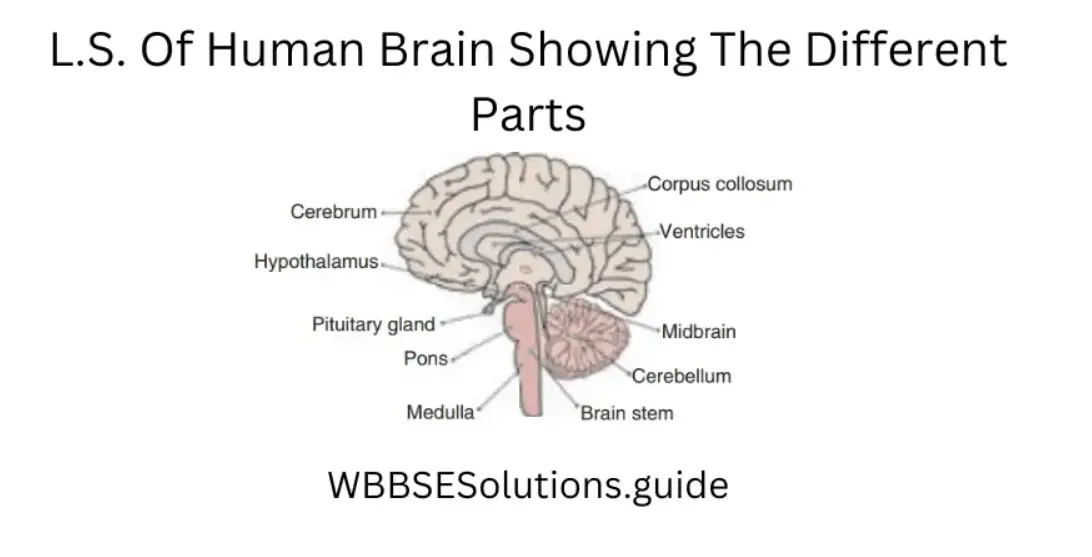
Functions: 1. It is the reflex center of every movement and auditory response.
2. The lower part of mid brain is associated with muscular reflexes and balancing reflexes. Mid brain can not be easily distinguished as it is enclosed by the forebrain.
(2) LH: In males, it is known as ICSH. (1) In Female: It controls ovulation.
(2) In Male: It helps the secretion of testosterone hormone.
Question 51. Mention the structure & functions of different parts of the hindbrain.
Answer.
Hindbrain: It consists of the cerebellum on the dorsal side and the brain stem (pons and medulla) on the ventral side.
Cerebellum: It is somewhat at the back of the head and consists of two cerebellar hemispheres just like the cerebrum. It also has grey matter on the surface and white matter in the central part It gives the appearance of two halves of a large walnut
Function:
(1) It is a large reflex center for the coordination of muscular body movements and
(2) maintenance of posture or equilibrium.
(3) The cerebellum is also associated with certain voluntary muscular movements originating in the forebrain.
Pons: It lies just above the medulla and acts as a bridge carrying ascending and descending tracts between the brain and spinal cord.
Function: It sends impulses to the cerebellum and controls breathing.
Medulla oblongata or medulla: It is the posterior-most part of the brain and continues into the spinal cord. Various ascending and descending tracts cross over from left to right and right to left in the medulla. Any damage to one of its sides causes paralysis on the opposite side of the body.
Function: 1. Since it carries the nerve tracts connecting the spinal cord to the brain, all communications between the brain and the spinal cord pass through it
2. It also contains the cardiac, respiratory, and vasomotor centers that control
complex activities like heart action, respiration, coughing, etc.
Question 52. What is a plant hormone? Name the different types of plant hormones.
Answer.
Plant hormone:
(1) Phytohormones: The organic compounds, synthesized in certain parts of the plants but exerting their influence in some other parts are called plant hormones
or phytohormones.
(2) In plants only five substances are officially classified as plant hormones. However, some other substances are being studied that may eventually be classified also as hormones.
The five main plant hormones are :
1. Auxin 2. Gibberellin 3. Cytokinin 4. Abscisic acid 5. Ethylene.
Wbbse Class 10 Life Science Question Answer
Question 53. What is auxin? How many types of auxin are there? Mention the physiological functions of auxin.
Answer.
Auxin:
(1) Auxin is a generic term applied to those hormones whose primary function is cell elongation.
The first auxin to be discovered is Indole 3-acetic acid (IAA). Other auxins, either natural or synthetic, resemble IAA in their physiological effects.
(2) The natural and synthetic auxins are as follows :
1. Natural Auxin: Auxins which are synthesized in plants are called natural auxins. Ex : IAA (Indole acetic acid), IPA (Indole propionic acid).
2. Synthetic Auxin: Auxins which can be synthesized in the laboratory are called synthetic auxins. Ex: NAA (Naphthalene acetic acid), IBA (Indole butyric acid); 2, 4-D (2, 4-Diclorophenoxy acetic acid), MCPA (2 Methyle 4-Chloro Phenoxy Acetic acid).
(3) The major physiological functions of auxins are as follows
1. Cell elongation
2. Apical dominance.
3. Phototropism
4. Geotropism
5. Root initiation
6. Parthenocarpy.
Delaying senescence of leaves by preventing the formation of abscissions layer.
Question 54. What are gibberellins? Who isolated them? Mention the functions of gibberellins.
Answer.
Gibberellins:
(1) Gibberellins are phytohormones first extracted from the fungus Gibberella fujikuroi (Fusarium moniliforme), the fungus that causes the banana disease, also called foolish seeding disease.
(2) The first Gibberellin was isolated in crystalline form by Yabuta and Sumiki in 1938. Chemically they are related to compounds called terpenoids.
(3) The major physiological functions of gibberellins are as follows:
1. Elongation of internodes.
2. Promotion of flowering.
3. Induction of parthenocarpy.
4. Breaking dormancy of the seeds and buds.
5. Induction of bolting, i.e., conversion of genetically dwarf plants into tall plants as well as their flowering.
Question 55. What are cytokinins? Who discovered it? Mention the important functions of cytokinins.
Answer.
Cytokinins:
(1) Cytokinins are phytohormones which induce cell division.
(2) The first cytokinin named kinetin was discovered by Miller and Skoog in 1954. Kinetin is a 6-furfury laminopurine – a degradation product of nucleic acid. Later in 1964 Letham and Miller isolated another cytokinin named Zeatin from corn milk, i.e., extract of immature corn (maize) caryopses. However, the most widely occurring cytokinin in plants is isopentenyl adenine (IPA).
(3) The major functions of cytokinins are as follows :
1. Induction of cell division.
2. Cell enlargement
3. Root and shoot initiation.
4. Breaking of seed and bud dormancy.
Question 56. Mention the source of the auxin hormone. Discuss the functions of that hormone in the plant body.
Answer.
(1) Source: Meristematic cells of growing regions like root tip, and shoot tip.
(2) Functions of auxin :
1. Cell division: Auxin hormone helps in nuclear division and thus promotes cell division. As a result, cells divide profusely which causes the growth of the meristematic region.
2. Cell elongation: Auxin softens the cell wall by removing calcium linkage present in the cell wall. It increases the uptake of water in the cell, thus the size of cells increases.
3. Callus formation: Auxin helps in callus formation for the healing of wounds. When applied to cuttings or wounds the permanent cells of the pith and the cortex region divide and redivide to form a callus – a wound tissue.
4. Cambial activity: Cambium cells become active due to the movement of IAA (Indole Acetic Acid) from the developing buds towards the region of reactivation of cambium during the growing season and take part in secondary growth.
5. Apical dominance: Auxin allows the growth of the apical or terminal bud and inhibits the growth of lateral buds.
6. Xylem formation: Auxin helps in xylem formation. The division of xylem cells takes place in the presence of auxin
7. Tropic movement: Auxin occurs at the root apex and stem apex. Auxin tends to move away from the light and towards gravity.
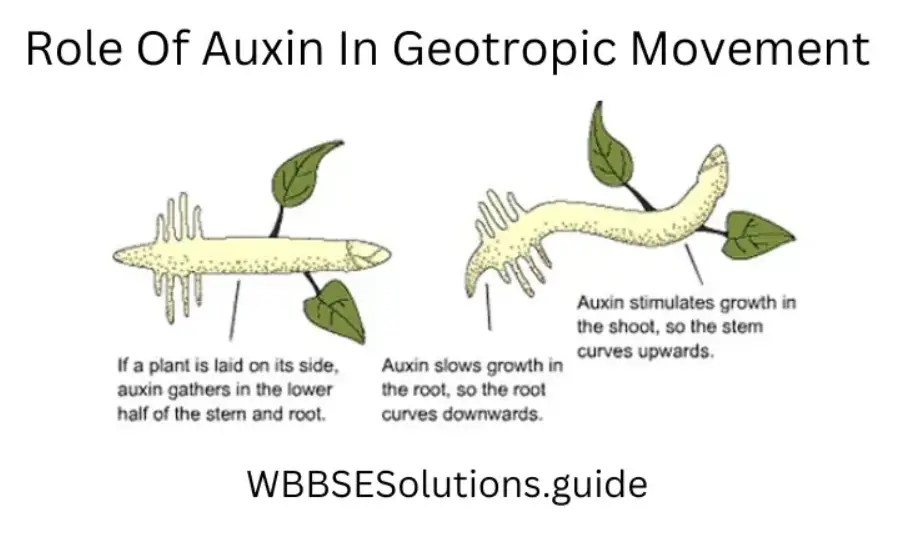
Auxin controls two types of movement:1) Phototropic movement – When light falls the auxin moves towards the darker side. The action of auxin is different in stem and root In stem more auxin causes more growth while in root more auxin causes less growth. So the stem moves towards the light showing positive phototropism and the root moves away from the light, that is towards the dark showing negative phototropism.
2) Geotropic movement – As stated earlier, the auxin moves towards gravity. More auxin causes more growth in the stem so it grows away from gravity showing negative geotropism and as more auxin causes less growth in the root it moves towards gravity showing positive geotropism.
Question 57. Name the different hormones secreted from the anterior pituitary gland. What are their functions? Mention the hyper and hypo activities of the anterior pituitary gland.
Answer.
The different hormones secreted from the anterior pituitary are :
(1) ACTH, (2) GH (3) TSH, (4) GTH.
(1) Functions of ACTH :
1. Stimulates adrenal glands to produce cortisone.
2. It also affects profound changes in the adrenal structure.
3. It stimulates lipolysis in adipose tissue and mobilises fat from it, this is called adipokinefic active of ACTH.
(1) Hypersecretion leads to Cushing’s disease.
(2) Hyposecretion leads to Addison’s disease.
(2) Functions of STH :
1. Promotes overall growth of the body.
2. Increases metabolism.
3. Reduces nitrogen excretion.
4. Promotes protein synthesis.
5. Promotes blood sugar level.
6. Reduces fat
7. Stimulates lactation in women after childbirth.
(1) Hypersecretion causes Gigantism in infants and Acromegaly in adults.
(2) Hyposecretion causes Dwarfism in infants and Simmond’s disease in adults.
(3) Functions of TSH :
1. It stimulates the growth and secretion of the thyroid gland.
2. It increases the iodine uptake.
3. It affects general metabolism.
4. It stimulates glycolysis & TCA cycle.
5. It enhances the release of stored thyroid hormones.
(1) Hypersecretion leads to Grave’s disease.
(2) Hyposecretion results in the enlargement of the thyroid gland.
(4) Functions of GTH: It influences Gonads (ovary & testis). It is of two types –
(1) FSH & (2) LH or ICSH.
(2) FSH: 1) In Females: Oestrogen secretion: It is a gonadotrophic hormone. It is gametogenic in action and stimulates the development of the ovarian follicles and secretion of estrogen hormone.
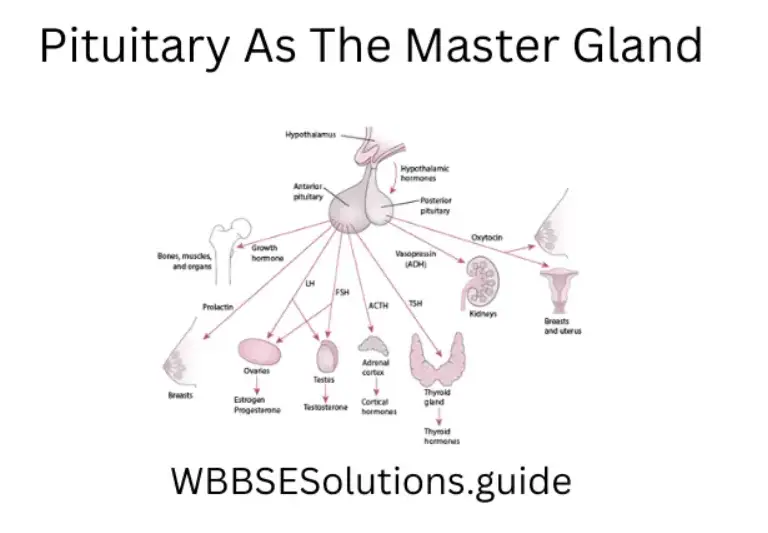
2) In Male: Spermatogenesis: It helps in cortex spermatogenesis (formation) of sperms.
(2) LH: In males, it is known as ICSH. (1) In Female: It controls ovulation.
(2) In Male: It helps the secretion of testosterone hormone.
Question 58. Mention the site of secretion and function of the Thyroxin hormone. What are the effects of its hypo and hypersecretion?
Answer.
(1) Site of Secretion – Thyroid gland.
Functions of Thyroxine (a calorigenic hormone) :
1. Regulates basic metabolism (BMR).
2. Controls absorption of glucose from the intestine.
3. Increases the blood sugar level.
4. Increases the heartbeat, cardiac output & blood pressure.
5. Controls body temperature by calorigenic effect
6. Causes normal development of the central nervous system.
7. Helps in the maturation of R.B.C.
(1) Hypersecretion causes Grave’s disease or Exophthalmic goiter.
(2) Hyposecretion causes Cretinism in children, Myxoedema in adults & Simple
Goitre (swelling of the neck, i.e., enlargement of the thyroid gland).
Question 59. Mention the site of secretion of Insulin. Discuss the functions of this hormone. Mention its hyper and hypo action.
Answer.
Site of Secretion: B cells of Islets of Langerhans of the pancreas.
(1) Functions of Insulin :
1. Glucose absorption: It influences glucose absorption in muscles and adipose tissues.
2. Controls glucose metabolism: Under its influence synthesis of glycogen from glucose in muscles and liver increases. It also reduces the breakdown of glycogen into glucose.
3. Antiketogentic: Under its influence lipids are inhibited from oxidation to produce ketone (acetone) bodies, therefore, insulin is termed as an anti-ketogenic hormone.
Hypersecretion of Insulin: Increased insulin secretion leads to hypoglycemia, i.e., decreased glucose level in the blood.
Hyposecretion of Insulin: Less insulin secretion leads to diabetes mellitus.
Question 60. Mention the site of secretion of adrenaline hormone. Discuss the function of this hormone. Mention its hyper and hypo activities.
Answer.
Site of secretion: Medulla of the adrenal gland.
(2) Functions of Adrenaline: Emergency hormone: It helps to control sudden excitement by influencing the nervous system and increasing blood flow and, therefore, is known as an emergency hormone. Controls blood pressure: It influences the blood vessels and controls blood pressure. Influences respiration: It controls the muscles of the respiratory organs and
thereby influences respiration. 3-F’s Hormone: Under conditions of fight, flight, or fright it causes changes that increase the efficiency of the animal.
For Eg.: (1) Increases heartbeat and breathing.
(2) Diversion of blood from the gut to muscles.
(3) Conversion of glycogen to glucose in the liver.
Hypersecretion: It causes rapid heartbeat, headache, and high.blood pressure, excess glucose in the blood. It also causes Cushing’s syndrome.
Hyposecretion: Addison’s disease: in the early stage of the disease, symptoms
are dark pigmentation of the skin (especially the hand, neck, and face).
Question 61. Name the hormones secreted from gonads. Mention their functions.
Answer.
1. Ovary and testis (singular) are known as gonads. The ovaries are paired oval bodies located in the pelvic cavity of a female. The important hormones secreted by the ovaries are estrogen, progesterone, and relaxin.
(1) Oestrogen: Site of secretion: Graffican follicle of the ovary, placenta.
Function : (1) Oestrogen stimulates the growth, development, and functional activities of primary and secondary sex organs.
(2) It regulates the menstrual cycle and stimulates breast development
(3) Oestrogen also has a cholesterol-lowering effect
Hypersecretion: It leads to disturbance in menses or cancer formation.
Hyposecretion: It causes failure of menses and ill-developed genital tract
(2) Progesterone: Site of Secretion: Corpus luteum of the ovary.
Functions : (1) Promotes secretory changes in uterine endometrium for pregnancy,
(2) implantation of zygote and
(3) formation of placenta,
(4) Also promotes the development of mammary glands.
Hyposecretion causes abortion and misconceptions.
2. Testes (plural) are located in the scrotal sac, hanging outside of the body at the junction of two legs in males. The main hormone secreted from the testis is Testosterone. Site of secretion: Interstitial cells of Leydig cells of the testis.
Functions :
(1) They are required for the normal maturation of sperm.
(2) Effect the growth of accessory sex organs, (3) development of secondary sexual characters in males, and (4) inhibits thymus.
Hyposecretion causes poor development of sexual characters leading to feminism.
Wbbse Class 10 Life Science Question Answer
Question 62. In the human body, locate the different endocrine glands.
Answer.
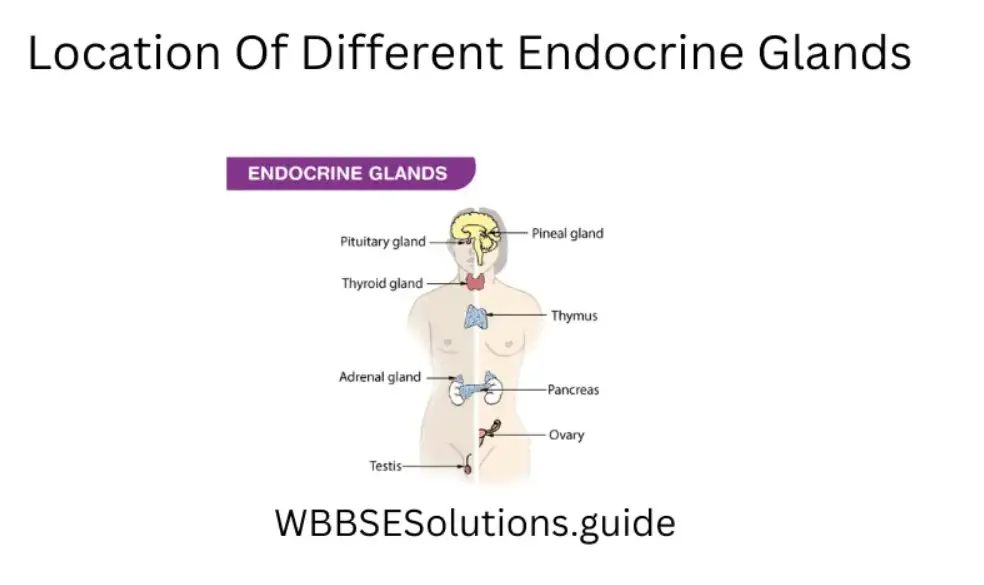
Question 63. Briefly describe the mechanism of sensing environmental changes and stimuli in plants.
Answer.
Mechanism of sensing environmental changes and stimuli in plants:
(1) Plant organs sensing light with photosensitive compounds: They are also called phototropins, cryptochromes, and phytochromes, each reacting very specifically to certain wavelengths of light These light sensors tell the plant whether it is day or night, how long the day is, how much light is available and from where the light comes.
Shoots grow towards light and roots usually grow away from light. These responses are called phototropism and skototropism respectively. This phenomenon is brought about by the plant hormone along with the pigments mentioned above.
Many plants exhibit certain phenomena at specific times of the day; for example, certain flowers open only in the mornings. Plants keep track of the time of the day with an internal molecular clock. This internal clock coupled with the ability to perceive light also allows plants to measure the time of the day and so find the season of the year.
The seeds of many plants sprout only after they are exposed to light This response is carried out by phytochrome signaling. Plants are also able to sense the quality of light and respond appropriately.
For example, in low light conditions, plants produce more photosynthetic pigments. If the light is very bright or if the levels of harmful UV increase, plants produce more of their protective pigments, that act as sunscreens.
(2) Production of signaling molecules: Wounded tomatoes are known to produce the volatile odor methyl-jasmonate as an alarm signal. Plants in the neighborhood can then detect the chemical and prepare for the attack by producing chemicals that defend against insects or attract predators.
(3) Hormonal signaling in plants: Plants systematically use hormonal signaling to coordinate their development and morphology. Morphogenesis in a developing plant is brought about by a delicate balance between auxin and cytokinin. Phytochrome, gibberellin, and the hypothetical hormone florigen bring about the modification of apical meristem to floral meristem.
(4) Trapping of prey by insectivorous plants: Stinging hairs of insectivorous plants like Sundew close the leaflets when they come in contact with the insect body. This is primarily due to the monastic movement
(5) Shock-based movement in plants: Any type of mechanical or electrical pressure releases the water molecule from the pulvinus in Mimosa pudica and the plant droops down. After some time with the discontinuity of the touch, the plant again regains its original configuration.
This is called the seismonastic movement This was denoted by Acharya J.C. Bose, who showed that a low electricity shock of 1.3 volts can result in drooping and retraction movement in Mimosa pudica.
Bose uses a crescograph to measure the rate of growth of a plant which is a device to magnify plant growth up to 10,000 times when they are stimulated by different stimuli like temperature, chemicals, gases & Electricity and thereby they not only proved that plants have life but also showed that they show varied responses to stimuli.
6) Movement due to osmotic stress: The leaflets of the Indian Telegraph plant Desmodium gyrans automatically go up and down with the loss and gain of turgidity of the basal leaflets. As the leaflets go down, they lose turgidity, become light, and go up.
(7) Growth movement due to touch: The tendril of a pea or vine grows like a spring-surrounding a solid rod-like support and there by the plant despite having a non-woody stem that can stand to erect This phenomenon occurs by the initial touch of the solid support causing the bending of the tendril (thigmotropism) followed by growth in the spring like manner (circumnutation).
Wbbse Class 10 Life Science Question Answer
Question 64. How are the physiological activities of plants regulated to increase agricultural yield?
Answer.
Regulation of physiological activities of plants leading to an increase in Agricultural Productivity :
(1) Apical growth of plant shoots and roots is promoted by auxin, so plant size decreases.
(2) Healing of wounds by the formation of callus tissue through auxin prevents infection or insect damage.
(3) Prevention of abscission of leaves by auxin causes pre-harvest loss of leaves.
(4) Parthenocarpic (seedless) fruit development with the help of auxin makes fruit like grapes economically more viable.
(5) Destruction of weed hosts with certain synthetic auxin compounds like 2,4-D reduces the competition from different weed plants.
(6) Initiation of intercalary growth by elongating the internode by gibberellin (GA3), induces growth for different stem vegetables.
(7) Transformation of apical bud to floral bud by GA3, induces more branching.
(8) Gibberellin induces early germination of seed.
(9) Morphogenesis by the induction of root or shoot through auxin-cytokinin balance is very useful for plant tissue culture.
(10) Cytokinin induces a bushy habit of a plant which is useful for plants like tea, where more apical buds and leaves are required.
Question 65. Briefly explain with examples the chemical coordination in the human body.
Answer.
There are several examples of coordination in our body —
(1) Goosebumps, result from the erection of the hairs in our skin. It is an involuntary, or uncontrollable response to cold temperatures or strong emotions. When we are in a cold environment, our thermoreceptors signal to our brain that our body temperature is decreasing.
This triggers the release of the hormone epinephrine (adrenaline), which targets the erector pili (smooth muscles surrounding hair follicles) and causes them to contract The contraction of these muscles causes our hairs to stand erect. These raised hairs cause the insulating air layer to expand, allowing your body to retain more heat.
(2) Most cells in the human body use the sugar called glucose as their major source of energy. To ensure a constant supply of glucose to cells, blood glucose levels must be maintained at relatively constant levels. In a healthy person, blood glucose levels are restored to normal levels primarily through the actions of two pancreatic hormones, namely insulin and glucagon.
(3) In the modern environment one is exposed to various stressful conditions. Stress can lead to changes in the serum level of many hormones. Some of these changes are necessary for the fight or flight response to protect oneself.
Adrenaline, along with nor-epinephrine is largely responsible for the immediate reactions we feel when stressed and combating stress. Along with the increase in heart rate, adrenaline also gives you a surge of energy that you might need to run away from a dangerous situation and also focuses your attention.
(4) Blood pressure is the pressure exerted by circulating blood upon the walls of vessels. Hormonal responses exist for both lowering and raising blood volume. The kidneys provide a hormonal mechanism (the renin-angiotensin-aldosterone system) for the regulation of blood pressure by managing blood volume.
Epinephrine and nor-epinephrine hormones, secreted by the adrenal medulla, raise blood pressure by increasing heart rate and the contractility of the heart muscles and by causing vasoconstriction of arteries and veins.
Antidiuretic hormone (ADH), a hormone produced by the hypothalamus and released by the posterior pituitary, raises blood pressure by stimulating the kidneys to retain water (raising blood pressure by increasing blood volume).
(5) Basal Metabolic Rate (BMR) is the rate of energy expended by animal (such as human) bodies when at rest. The thyroid hormones triiodothyronine (T3) and thyroxine (T4) are the main regulators of BMR. BMR increases when the quantity of these hormones in the blood increases. Some other hormones such as testosterone, insulin, and human growth hormone (HGH) can also increase the body’s metabolic rate.
(6) Sex Hormones: In most animal species the brain controls and regulates sexual behavior primarily using hormones. The sex hormones are estrogen and testosterone. Sexual behavior is influenced by the hypothalamus. It stimulates the pituitary gland to release the sex hormones.
In the female the target gland of the gonadotrophic hormone is the ovary, the ovary has two functions, the first one is to produce eggs, and the other is to secrete hormones. Estrogen and progesterone are the hormones released by the ovary?
Question 66. “Accommodation is the ability of the eye lens to adjust its focal length”. Explain the statement.
Answer.
Accommodation- viewing near and distant objects:
The accommodation is a reflex action of the eye, in response to focusing on a near object, then looking at a distant object (and vice versa), comprising coordinated changes in convergence, lens shape, and pupil size.
The lens is responsible for accommodation, the adjustment of the eye for observing near or far objects. It does this by changing its shape. This changes the focal length of the lens and permits it to focus the image formed on it by the cornea.
The lens is suspended from the muscular ciliary body by many delicate zonule fibers attached to its equator. In the normal relaxed condition (that is, with no tension placed on the fibers by contraction of the ciliary muscle) the lens’ shape is such as to refract rays from distant objects, and the eye is focused at infinity.
Accommodation for close vision requires tension to be exerted to deform the lens. Contraction of the muscles of the ciliary body tugs at the fibers and changes the shape of the lens. The eye adjusts the shape of the lens to keep objects in focus.
Looking at distant objects: Ciliary muscles relaxed -*• lens becomes thin -»• focal length of the lens increases. Looking at objects closer to the eye: Ciliary muscles contract -*ÿ increases the curvature of the eye lens -*• lens becomes thick -*ÿ focal length of the lens decreases.
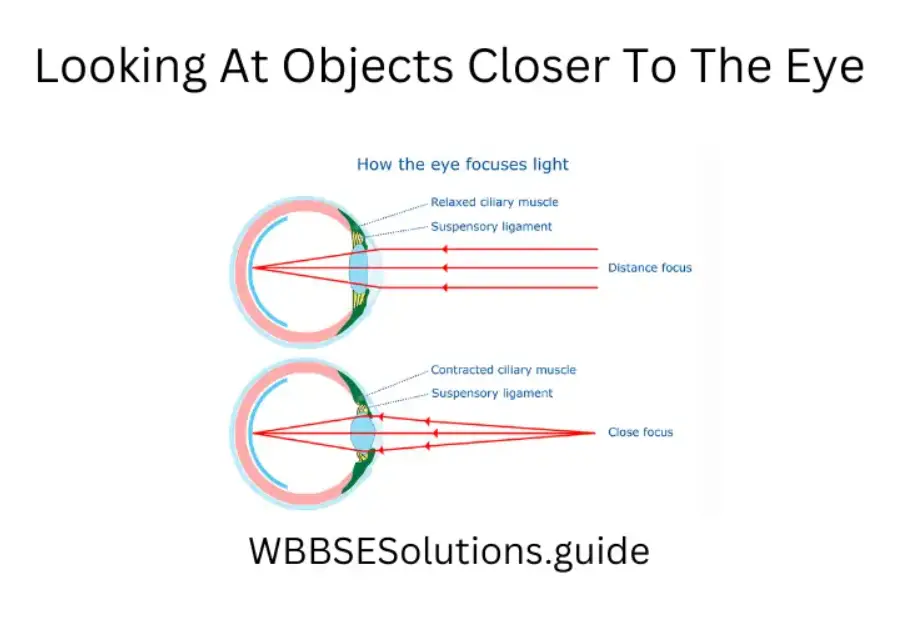
An example of accommodation can be cited from daily life situations. Good driver vision is a crucial factor in road safety, both for the pedestrians and passengers of the car. This is required to avoid road accidents by taking note of obstacles, traffic signals, and road directions.
Distance acuity is probably the most important visual skill for driving. Distance acuity is the ability to focus and see clearly at far distances. Even the simplest reactions in driving take at least 0.4 seconds.
A driver has to change focus quickly and easily from the road to the dashboard and back again. Being able to see color is also pretty important in the car.
Question 67. Briefly explain different defects of vision and their corrective measures.
Answer.
Defects of visions and corrective measures:
A -person with normal eyes can, by accommodation, see all objects that are at a distance greater than about 25 cm from the eye. If due to certain abnormalities the eye is unable to accommodate itself to various distances, then the eye is said to be defective. Some common defects of the eye are –
(1) Myopia: Near-sightedness, also called myopia is a common name for impaired vision in which a person sees near objects clearly while distant objects appear blurred. In such a defective eye, the image of a distant object is formed in front of the retina and not at the retina itself. Consequently, a nearsighted person cannot focus clearly on an object farther away than the far point of the defective eye.
Causes: This defect arises because the power of the eye is too great due to the decrease in focal length of the crystalline lens. This may arise due to either-(1) excessive curvature of the cornea, or (2) elongation of the eyeball.
Correction: This defect can be corrected by using a concave (diverging) lens. A concave lens of appropriate power or focal length can bring the image of the object back to the retina itself.

(2) Hyperopia or hypermetropia: Farsightedness, also called hyperopia or hypermetropia, common name for a defect in vision in which a person sees near objects with blurred vision,
while distant objects appear in sharp focus. In this case, the image is formed behind the retina.
Cause: This defect arises because either (1) the focal length of the eye lens is too great, or (2) the eyeball becomes too short, so that light rays from the nearby object, say at point
N, cannot be brought to focus on the retina to give a distinct image.
Correction: This defect can be corrected by using a convex (converging) lens of appropriate focal length. Eyeglasses with converging lenses supply the additional focusing power
required for forming the image on the retina.
(3) Presbyopia: Presbyopia is a progressive form of farsightedness that affects most people by their early 40s. The power of accommodation of the eye decreases with aging. Most people find that the near point gradually recedes.
Causes: It arises due to the gradual weakening of the ciliary muscles and diminishing flexibility of the crystalline lens.
Correction, Simple reading eyeglasses with convex lenses correct most cases of
presbyopia. Sometimes, a person may suffer from both myopia and hypermetropia.
Such people often require bi-focal lenses. In the bi-focal lens, the upper portion of the bi-focal lens is a concave lens, used for distant vision. The lower part of the bi-focal lens is a convex lens, used for reading purposes.
Question 68. What do you mean by bipedal locomotion? what are the characteristics of plant hormones?
Answer.
Bipedal locomotion
In the animal kingdom, only man has the effective capacity to walk and run on his two legs. Locomotion in man is la affected by the movement of legs, though the hands keep the balance of the body, Thistle moving.
The kind of locomo is called the bipedal locomotion.
1. They are mainly produced at the tips, root tips, etc.
2. Plant hormones are natural, artificial, and postulated.
3. Chemically plant hormones are acidic or alkaline in nature.
4. Plant hormones are secreted from meristematic cells.
5. These are transported from the site of secretion to the site of action by conducting tissues, mainly by phloem.
6. Plant hormones are mostly growth hormones.
Question 69. What are the characteristics of hormones? What are the characteristics of animal hormones? How is nerve impulse transmitted through synapse?
Answer.
Characteristics of hormones
1. These are present in the body in minute quantities and can act at very low concentrations.
2. They often act at a site remote from their site of production.
3. They are transported through the body fluids.
4. A hormone may act at more tissue tissue target tissues.
5. They are degraded after their actions are over.
6. They influence the activity of a process but cannot initiate a pro-quick-acting quickly acting (slow-acting or acting (estrogen).
2. These are secreted from the endocrine glands.
3. It is carried from the site of secretion to the target organ by the blood flow.
4. It acts in a very low concentration.
5. It is destroyed and excreted as soon as its function is over.
6. Chemically they steroids steroid site peptides steroid or peptides in nature.
7. Perform various activities including the growth of the organism.
8. They help the body cope with emergency demands such as infection, trauma,
emotional stress, dehydration, starvation, hemorrhage, and temperature extremes.
They are secreted in response to specific stimuli.
When an impulse arrives at the tip of the axon it releases neurotransmitters like adrenaliacetylcholineholine from the synaptic vesicles. The chemical diffuses across the synaptic cleft and reaches the dendrite of the next neuron causing depolarization of the membrane there. A new impulse then passes through the next neuron.
Question 70. Write the common characteristic features of the endocrine gland cataract cataracts cataract occur. How can it be rectified?
Answer.
1. Anatomical characters — The endocrine glands are devoid of excretory ducts and are highly vascularised.
2. Chemical characters — They synthesize some definite hormones and secrete them into the blood leaving the organ.
3. Functional — The materials secreted by such glands have some definite physiological actions. That means each gland has some definite functions in the body as evidenced by the fact that surgical removal of the gland leads to impairment of certain physiological functions that are corrected by administration of the gland extract to the animal.
The reason for this defect is that the lens loses its transparency and becomes opaque due to the deposition of protein materials and calcium minerals in the lens. This opaque the e condition of the lens does not allow the light rays from objects to pass through the lens. This defect can be rectified by surgically removing the lens and it has to be replaced by a highly convex lens.
Question 71. Which animal hormone was discovered first? Write its origin and function. What was the contribution of Acharya Jagadish Chandra Bose to sensitivity in plants?
Ans. (1) Secretin.
(2) Secretin is secreted from the small intestinal mucosa. It stimulates the secretion of bile from the liver as well as the secretion of bicarbonate and water in the pancreatic juice. Acharya Jagadish Chandra Bose made substantial discoveries in plant physiology. One of his inventions is the Crescograph, which he used to measure plant’s response to different stimuli. He demonstrated with experiments that plants too crescographph Crescograph was used to record the plant pulses when it was connected to a plant called Desmodium gyrans.
The plant root was hydrobromic hydrobromic acid till its set, m. Initially, the plant showed a steady deflection of the pointer in the crescograph and soon it became unsteady and then vibrated violently and finally stopped suddenly, indicating the death of the plant
Question 72. What is apical dominance? Name the hormone responsible for the formation of lateral buds. How can apical dominance be demonstrated sensitivity Sensitivity?
Answer. (1) Apical dominance is a physiological phenomenon in plants in which the growth of the apical bud inhibits the development of lateral buds.
(2) Auxin is the hormone responsible for the formation of lateral buds.
(3) Apical dominance can be easily demonstrated by cutting the API, and cal the bud because in the absence of the apical bud, active growth starts in the lateral buds. Sensitivity is the ability to detect the change in the environment and react to the stimuli. It is moreanimalssunced in animals the ability to show locomotion. Some of the lower plants can exhibit locomotion like in unicellular or colonial green algae and their response to stimuli is easily detectable which is in terms of positive or negative tactic movement But higher plants are fixed to the substratum with the help of roots and they cannot move from place to place, so they exhibit growth movement which is very slow and cannot be de CrtnCertain Though
certain plants are relatively more sensitive and they exhibit turgor movement in response to electrical or mechanical shock.
Question 73. (1) What is auxin? (2) What is its role in phototropism? Mention any two functions of GTH.
Answer. (1) Auxin is a class of plant growth hormone. It is produced at the tips of root & shoot.
(2) Phototropism is the movement of plant parts towards or away from light Auxin controls this movement by its differential presence in a particular area causing unequal rates of growth of the two sides of that plant part functions to functions of G.Follicle-stimulatingcle stimulating hormone increases, the growth of ovary stimulates to secrete estrogen from Grafian follicles in females and in males it stimulates seminiferous tubules of the testis and causes spermatogenesis.
(2) Luteinising hormone stimulates corpus luteum in females to seprogesteroneer one, and in males, it stimulates the interstitial theal cells of the testis to secrete testosterone.
Question 74. Classify animal hormones according to their chemical nature giving three examples of each class a ss. What is a hormone?
Answer. Animal hormones are chemically of three types
(1) Protein or peptide hormones: Ex – STFI, ACIH, insulin.
(2) Amines & modification acids: Ex – Adrenaline, thyroxine, melatonin.
(3) Steroid hormones : Ex – Estrogen, progesterone, testosterone.
(1) Hormones are organic substances produced by a group of cells in one part of the body that after being transported by body fluid influence growth and other physiological activities at a site remote from its place of production.
(2) Hchemical agents agent released from one group of cells which travel through the body fluid to affecgroupsgroupsferent group of cells. (Bayliss and Starling -1904).
Question 75. What are the functions (importance) of the nervous system? Define thermonasty with an example.
Answer.
Functions (importance) of the nervous system
(1) It controls all the voluntary and involuntary activities.
(2) It regulates and coordinates the activities of the bodies.
(3)It receives, transmits andinformationinformations, and then formulates a response for the effector organs.
(4) It helps in thinking and learning.
(5) It maintains the equilibrium of the body) It is the sum of the past incidents and experiences.
(ininIt helps in maintaining the integrity between an organism and the external environment.
(8) It is the seat of imagination, intelligence, judgment, ideas, etc.
(9) It also controls the emotional activities.
The movement of plant organs in variations to variation in temperature is known as thermonasFlowersower and s of tulips, crocus open when the temperature increases during daytime and clotemperatureee temperature falls at night.
Question 76. What is the the necessity of nervous system in the body? What i photo nasty? What is tropism?
Answer.
Necessity of nervous system in the body
The body of a man (or any other multicellular animal) is made of many organs specialized to perform different functions. In any society which includes people doing different sorts of work, an administrator is required to activities the activities of all the people.
Similarly in our body, a controller is required to coordinate and regulate all the functions (both voluntary and involuntary) andcoordinatorinator is no other than the nervous system. The movement of plant organs caused by the change in light intensity is called photonasty.
This type of movement occurs due to the o change in turgor pressure of certain cells involved in the movement of the organ. The tropic movements are the movements of the plant organs in which the direction of movement is determined by the direction of stimuli. If the movement is towards the source of the stimulus, it is called positive; if it is away from the source, it is called negative.
Question 77. What is the advantage of a seneuroneurone having numerous synaptic connections? What tactic movement?
Answer.
Across the synapse, the impulse is transmitted through chemicals, sucacetylcholineholine, and adrenaline. A sensory nerve has to carry the stimulus quickly to the brain or spinal cord across a synapse. This depends on moacetylcholineholine secretion which acts as a stimulus transmitter.
More synaptic connections increase the transmitting efficiency of the nervous stimulus. Tactic movement or Taxism: The movement of the entire plant, e.g. Chlamydomonas, Valvox, etpartspartsr plant parts like sperm antherozoids of moss or fern in response to external stimulus is called ‘tactic movement’ or ‘taxis’.
Question 78. Explain why nerve impulse flows more rapidly in myelinated nerve fibers than in non-myelinated fibers. What is the function of Corea in the human eye?
Answer.
In non-myelinated, nerve fiber depolarization changes are repeated all over the length of the fiber, so the action potential has to travel the entire length of the fiber. On the other hand, in myelinated fiber depolarization occurs only at nodes of Ranvier which do not contain the myelin sheath; so the action potential hops through nodes of Ranvier and is faster. This type of conduction is known as saltatory.
(1) It allows the light to pass into the eye.
(2) It acts as a refrective medium.
Question 79. Why should edible salt be ed? Where is testosterone produced? State one advantage of stereoscopic vision.
Answer.
Iodized edible salt helps in the formation of thyroxin because iodine is an essential part of it. So, if edible salt is not iodized the body will not get sufficient iodine; tha a ere will be a deficiency of thyroxin. Testosterone is setestesrom testets. The stereoscopic vision is of great importance for estimating the distance and shape of the object
Question 80. What is the the source of adrenalin hormone? What is it called an emergency hormone? What is stereoscopic vision?
Answer. (
1) Source of adrenalin hormone – AdrThe adrenalinalind.
(2) Adrenalin hormone one is known as emergency hormone. Reason It is the secretomes time of danger and helps to control excitement by influencing the nervous system and increasing blood flow, thereby helping the person to face the abnormal condition successfully.
The visit here-dimensional three dimensional) the aspect of the object portrayed is called stereoscopic vision.is found in animals having binocular vision, e.g. in man.
Question 81. Which hormone is released from the testes? Mention its functions.
Answer.
(1) Testosterone is the the released from the testes.
(2) Functions of testosterone
(1) It promotes the growth of secondary semalesmalesgans in males.
(2) It facilitates sperm production, (3) It also promotes the growth of muscles and bones.
Quesa a tion 82. Why is a hormone called chemical messenger? Mention the secretion motion and function of estrogen. What is hypermetropia and how can it be corrected? What is meant by “binocular vision”?
Answer.
(1) Because they have received order from their place of production (such as endocrine glands) and act accordingly on the target organs.
(2) (1) Site of secretion Graffian follicles of ovary.
(2) Function It helps in the development of female sex organs and the growth of mammary glands.
Haarmetropia ithe the s a defect of the eye ithe n which the person cannot see nearby objects. clearly but the distant vision is clear. It can be corrected by using a convex lens. The vision in which both eyes participate in viewing an object is called binocular vision, e.g. in man.
Question 83. Mention the place of secretion and function of Auxin, ACTHand, and Adrenaline hormone. What is myopia and how can it be corrected?
Answer.
Place of secretion and function
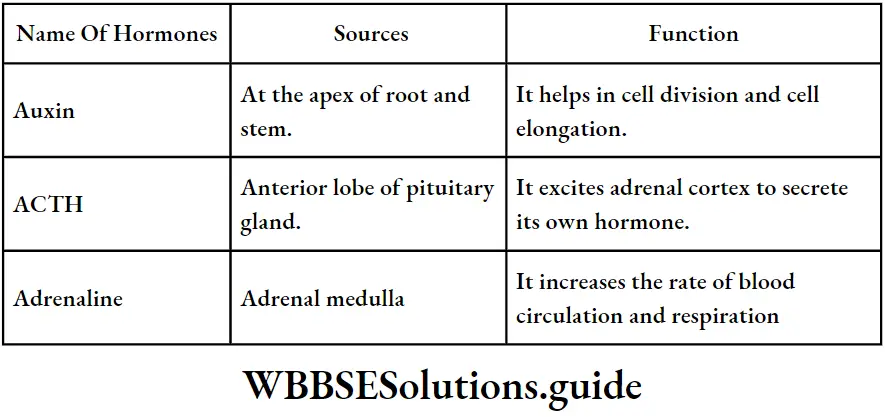
Myopia is the defect of the eye in which a person can see nearby things clearly but distant objects are blurred. It can be corrected by using a concave lens.
Question 84. Write two functions of each of ACTH, TSH and, STH in the human body. What type of lens is used to correct the following defects of the eyes: (1) Astigmatism (2) Myopia (3) Hypermetropia?
Answer.
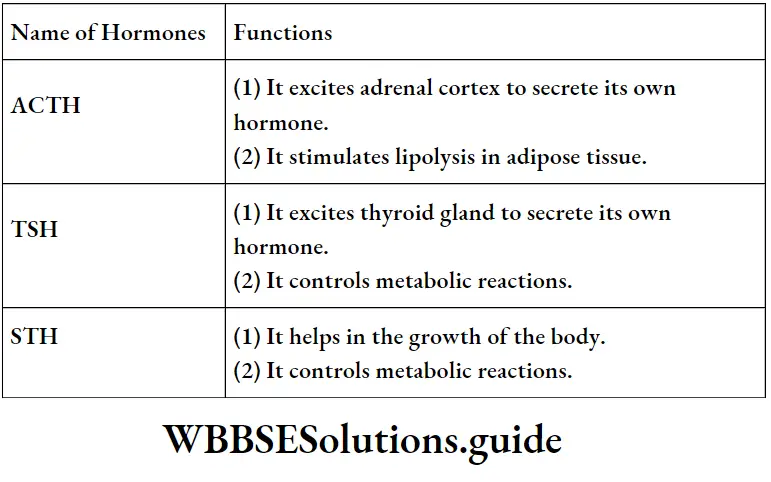
(1) Spherical lens (2) Concave lens (3) Convex lens.
Question 85. Name three animal hormones that are not secreted from the pituitary gland and mention their sources. Name some major eye defects of man.
Answer.
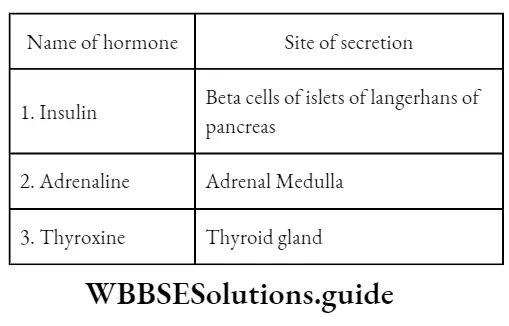
The major eye defects of man are – Myopia, Hypermetropia, Astigmatism, Glaucoma, CatarCataractsColour-blindness, etc.
Question 86. Write the full names of any three hormones secreted from the anterior pituitary gland. What types of visions are associated with rods and cones?
Answer.
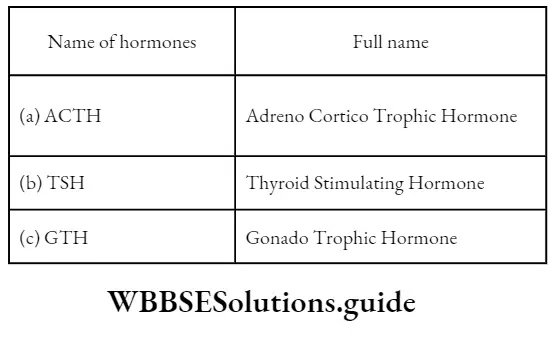
The rods are associated with night vision (dim light) and cones are associated with coloucoloron.
Question 87. Write any three characteristics of animal hoa a rmos. What is a blind spot?
Answer.
Three characteristics of animal hormone
(1) Their places of secretion (endocrine gland) and action are different
(2) They are concentrations concentration.
(3) The remaining quantity of hormone is destroyed and removed from the body by the process of excretion n.
The point on the retina having no rods and cones is called the blind spot It is insensitive to light so no image is formed here.
Question 88. What do you mean by endocrine and exocrine glands? Give examples. Mention the location of the nd function of the yellow spot.
Answer.
(1) Endocrine glands The duct the less glands of an animal body secrete the hormones directly into tbloodstreameam are known as endocrine glands. Ex.:-
Pituitary gland.
(2) Exocrine glands Glands that discharge their secretion through ducts are called exocrine glands. Ex. Salivary glands.
The yellow spot is located on the retina. It is responsible for the formation of the sharpest image.
Question 89. Mention the sites of secretion and functions of insulin and adrenaline hormones. What is ‘Fovea’ or ‘Yellow Spot’?
Answer.
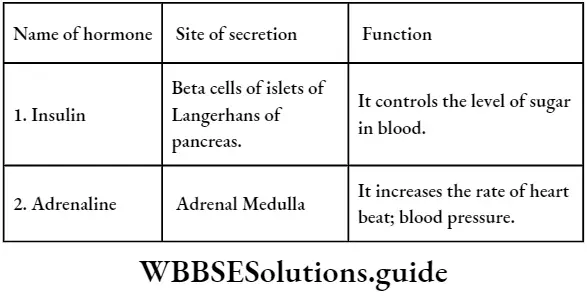
The fovea or yellow spot is the region on the retina just opposite the lens where cones are very densely packed.
Question 90. Give names of one plant hormone and two animal hormones and mention their functions. What is the function of aqueohumour vitrehumormour?
Ans.
(1) Plant Hormone – Auxin. Function It helps in growth and controls tropic movement.
(2) Animal Hormone (1) Thyroxine. Function It controls metabolic reactions.
(2) Insulin. Function maintains blood sugar level. humorous urus and vitreous humor maintain the spherical shape of the eyeball.
Question 91. Mention the place of secretion and two functions of each of GTH, Insulin, Thyroxine, and Adrenaline the hormones in the human body. What are receptors?
Answer. Place of secretion and two functions
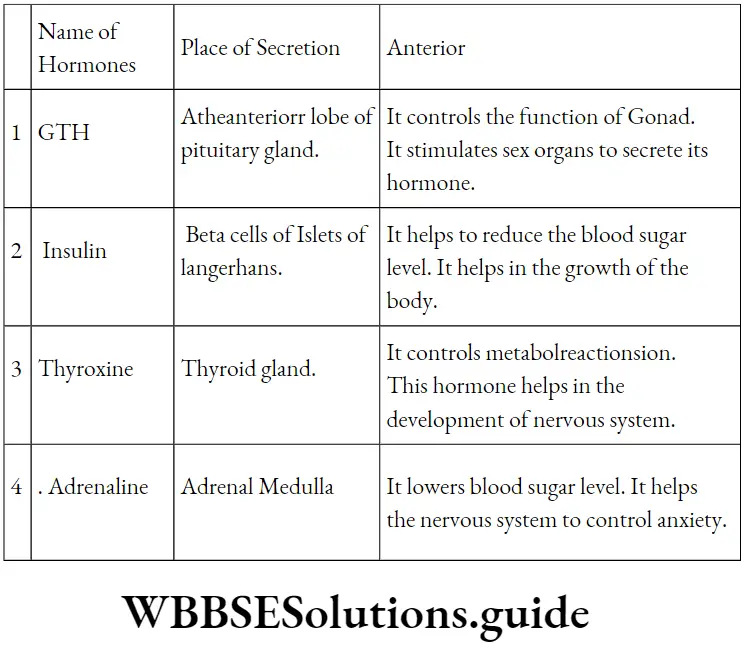
Structures at the end of sensory nerve fibers collect information from the external and internal environment of the body.
Question 92. Describe three important functions of gibberellins. Name the pigments present in rod and cone cells.
Answer:
The function of Gibberellin (1) It checks and inimizesises the dormancy period of seeds.
(2) It helps in parthenocarpy.
(3) It helps in the determination of sex.
Rod cells contain Rhodopsin and cone cells contain Iodopsin.
Question 93. What parthenocarpy? Mention two differences between Auxin and anHormone-producing more producing glands are called endocrine glands. Explain.
Answer.
Parthenocarpy
(1) Parthenocarpy The production of seedless fruit using artificial plant hormones but withfertilizingsoffthe the ovum is called parthenocarpy.
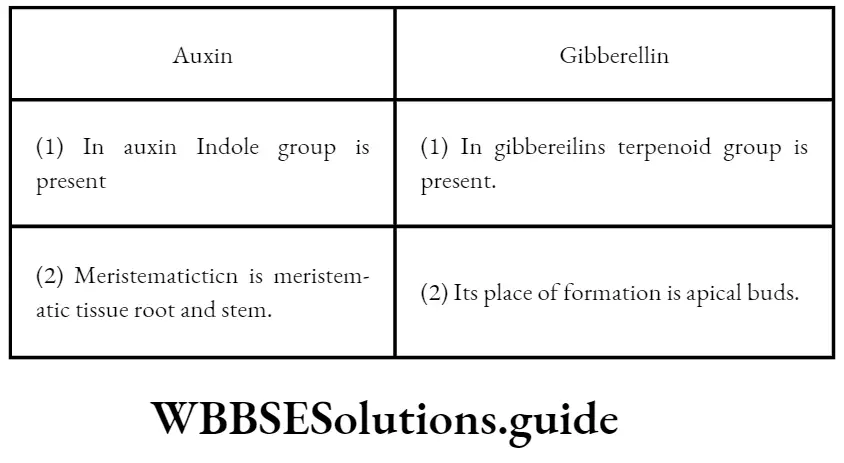
Because these ducts have no duct and in the absence of ducts they directly pour down their secretions (hormones) into the blood vessels.

